NTN
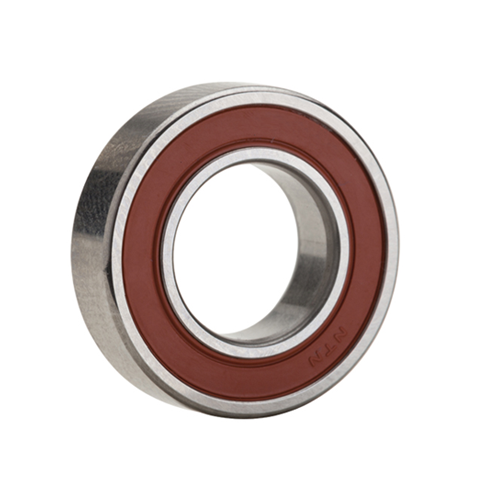
NTN NTN 6015LLU Deep Groove Ball Bearings , D=75
NTN 6015LLU Deep Groove Ball Bearings , D=75 SPECIFICATIONS Type of Product : Deep Groove Ball Bearing Model No : 6015LLU Width : 20 mm Inner Diameter : 75 mm 1. Design features and characteristics Deep groove ball bearings are very widely used. A deep groove is formed on the inner and outer ring of the bearing enabling the bearing to sustain radial and axial loads in either direction as well as the complex loads which result from the combination of these forces. Deep groove ball bearings are suitable for high speed applications. When two or more deep groove ball bearings are used in combination and mounted adjacent to each other a duplex set (D2) should be used. Duplex bearings (D2) utilize controlled tolerances to more evenly distribute the loading between the individual bearing rows which improves the overall performance of the assembly. In addition to unsealed and unlubricated “open” bearings, NTN provides deep groove ball bearings that are pre-lubricated with grease and enclosed by seals or shields. See section “11. Lubrication” for a list of some of the greases which can be used. Table 1 shows the construction and special characteristics of various sealed deep groove ball bearings. Types and codes N Shielded type Shielded type Non-contact type ZZ Non-contact type LLB Contact type LLU Low torque type LLH Construction Metal shield plate is affixed to the outside ring; the inner ring incorporates a V-groove and labyrinth clearance. The outer ring incorporates synthetic rubber molded to a steel plate; seal edge is aligned with V-groove along inner ring surface with labyrinth clearance The outer ring incorporates synthetic rubber molded to a steel plate; seal edge contacts V-groove along inner ring surface Basic construction is the same as LLU type, but a specially designed lip on the edge of the seal prevents foreign matter penetration; low torque construction. Torque Small Small Higher Medium Dust proofing Good Better than ZZ-type Excellent Much better than LLB-type Water proofing Poor Poor Very good Good High speed capacity Same as open type Same as open type Limited by contact seals Much better than LLU-type Allowable temp. range Depends on lubricant −25 to 120°C −25 to 110°C −25 to 120°C
$40.28
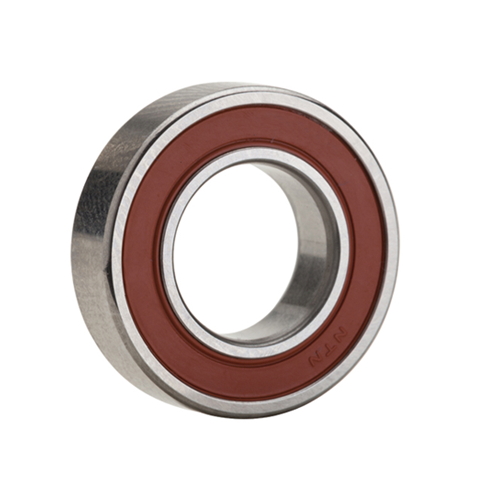
NTN NTN 6014LLUC3 Deep Groove Ball Bearings , D=70
NTN 6014LLUC3 Deep Groove Ball Bearings , D=70 SPECIFICATIONS Type of Product : Deep Groove Ball Bearing Model No : 6014LLUC3 Width : 20 mm Inner Diameter : 70 mm 1. Design features and characteristics Deep groove ball bearings are very widely used. A deep groove is formed on the inner and outer ring of the bearing enabling the bearing to sustain radial and axial loads in either direction as well as the complex loads which result from the combination of these forces. Deep groove ball bearings are suitable for high speed applications. When two or more deep groove ball bearings are used in combination and mounted adjacent to each other a duplex set (D2) should be used. Duplex bearings (D2) utilize controlled tolerances to more evenly distribute the loading between the individual bearing rows which improves the overall performance of the assembly. In addition to unsealed and unlubricated “open” bearings, NTN provides deep groove ball bearings that are pre-lubricated with grease and enclosed by seals or shields. See section “11. Lubrication” for a list of some of the greases which can be used. Table 1 shows the construction and special characteristics of various sealed deep groove ball bearings. Types and codes N Shielded type Shielded type Non-contact type ZZ Non-contact type LLB Contact type LLU Low torque type LLH Construction Metal shield plate is affixed to the outside ring; the inner ring incorporates a V-groove and labyrinth clearance. The outer ring incorporates synthetic rubber molded to a steel plate; seal edge is aligned with V-groove along inner ring surface with labyrinth clearance The outer ring incorporates synthetic rubber molded to a steel plate; seal edge contacts V-groove along inner ring surface Basic construction is the same as LLU type, but a specially designed lip on the edge of the seal prevents foreign matter penetration; low torque construction. Torque Small Small Higher Medium Dust proofing Good Better than ZZ-type Excellent Much better than LLB-type Water proofing Poor Poor Very good Good High speed capacity Same as open type Same as open type Limited by contact seals Much better than LLU-type Allowable temp. range Depends on lubricant −25 to 120°C −25 to 110°C −25 to 120°C
$36.86
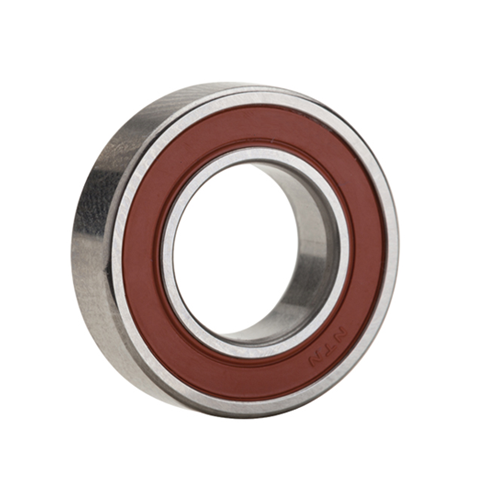
NTN NTN 6013LLUC3 Deep Groove Ball Bearings , D=65
NTN 6013LLUC3 Deep Groove Ball Bearings , D=65 SPECIFICATIONS Type of Product : Deep Groove Ball Bearing Model No : 6013LLUC3 Width : 18 mm Inner Diameter : 65 mm 1. Design features and characteristics Deep groove ball bearings are very widely used. A deep groove is formed on the inner and outer ring of the bearing enabling the bearing to sustain radial and axial loads in either direction as well as the complex loads which result from the combination of these forces. Deep groove ball bearings are suitable for high speed applications. When two or more deep groove ball bearings are used in combination and mounted adjacent to each other a duplex set (D2) should be used. Duplex bearings (D2) utilize controlled tolerances to more evenly distribute the loading between the individual bearing rows which improves the overall performance of the assembly. In addition to unsealed and unlubricated “open” bearings, NTN provides deep groove ball bearings that are pre-lubricated with grease and enclosed by seals or shields. See section “11. Lubrication” for a list of some of the greases which can be used. Table 1 shows the construction and special characteristics of various sealed deep groove ball bearings. Types and codes N Shielded type Shielded type Non-contact type ZZ Non-contact type LLB Contact type LLU Low torque type LLH Construction Metal shield plate is affixed to the outside ring; the inner ring incorporates a V-groove and labyrinth clearance. The outer ring incorporates synthetic rubber molded to a steel plate; seal edge is aligned with V-groove along inner ring surface with labyrinth clearance The outer ring incorporates synthetic rubber molded to a steel plate; seal edge contacts V-groove along inner ring surface Basic construction is the same as LLU type, but a specially designed lip on the edge of the seal prevents foreign matter penetration; low torque construction. Torque Small Small Higher Medium Dust proofing Good Better than ZZ-type Excellent Much better than LLB-type Water proofing Poor Poor Very good Good High speed capacity Same as open type Same as open type Limited by contact seals Much better than LLU-type Allowable temp. range Depends on lubricant −25 to 120°C −25 to 110°C −25 to 120°C
$30.84
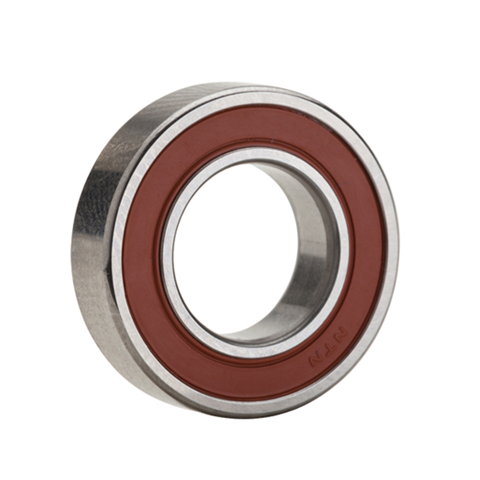
NTN NTN 6013LLU Deep Groove Ball Bearings , D=65
NTN 6013LLU Deep Groove Ball Bearings , D=65 SPECIFICATIONS Type of Product : Deep Groove Ball Bearing Model No : 6013LLU Width : 18 mm Inner Diameter : 65 mm 1. Design features and characteristics Deep groove ball bearings are very widely used. A deep groove is formed on the inner and outer ring of the bearing enabling the bearing to sustain radial and axial loads in either direction as well as the complex loads which result from the combination of these forces. Deep groove ball bearings are suitable for high speed applications. When two or more deep groove ball bearings are used in combination and mounted adjacent to each other a duplex set (D2) should be used. Duplex bearings (D2) utilize controlled tolerances to more evenly distribute the loading between the individual bearing rows which improves the overall performance of the assembly. In addition to unsealed and unlubricated “open” bearings, NTN provides deep groove ball bearings that are pre-lubricated with grease and enclosed by seals or shields. See section “11. Lubrication” for a list of some of the greases which can be used. Table 1 shows the construction and special characteristics of various sealed deep groove ball bearings. Types and codes N Shielded type Shielded type Non-contact type ZZ Non-contact type LLB Contact type LLU Low torque type LLH Construction Metal shield plate is affixed to the outside ring; the inner ring incorporates a V-groove and labyrinth clearance. The outer ring incorporates synthetic rubber molded to a steel plate; seal edge is aligned with V-groove along inner ring surface with labyrinth clearance The outer ring incorporates synthetic rubber molded to a steel plate; seal edge contacts V-groove along inner ring surface Basic construction is the same as LLU type, but a specially designed lip on the edge of the seal prevents foreign matter penetration; low torque construction. Torque Small Small Higher Medium Dust proofing Good Better than ZZ-type Excellent Much better than LLB-type Water proofing Poor Poor Very good Good High speed capacity Same as open type Same as open type Limited by contact seals Much better than LLU-type Allowable temp. range Depends on lubricant −25 to 120°C −25 to 110°C −25 to 120°C
$30.84
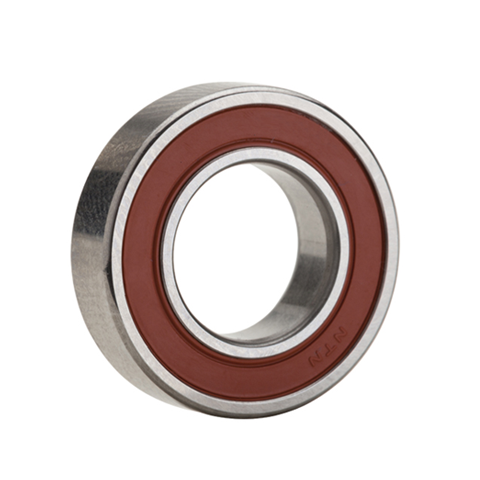
NTN NTN 6012LLUC3 Deep Groove Ball Bearings , D=60
NTN 6012LLUC3 Deep Groove Ball Bearings , D=60 SPECIFICATIONS Type of Product : Deep Groove Ball Bearing Model No : 6012LLUC3 Width : 18 mm Inner Diameter : 60 mm 1. Design features and characteristics Deep groove ball bearings are very widely used. A deep groove is formed on the inner and outer ring of the bearing enabling the bearing to sustain radial and axial loads in either direction as well as the complex loads which result from the combination of these forces. Deep groove ball bearings are suitable for high speed applications. When two or more deep groove ball bearings are used in combination and mounted adjacent to each other a duplex set (D2) should be used. Duplex bearings (D2) utilize controlled tolerances to more evenly distribute the loading between the individual bearing rows which improves the overall performance of the assembly. In addition to unsealed and unlubricated “open” bearings, NTN provides deep groove ball bearings that are pre-lubricated with grease and enclosed by seals or shields. See section “11. Lubrication” for a list of some of the greases which can be used. Table 1 shows the construction and special characteristics of various sealed deep groove ball bearings. Types and codes N Shielded type Shielded type Non-contact type ZZ Non-contact type LLB Contact type LLU Low torque type LLH Construction Metal shield plate is affixed to the outside ring; the inner ring incorporates a V-groove and labyrinth clearance. The outer ring incorporates synthetic rubber molded to a steel plate; seal edge is aligned with V-groove along inner ring surface with labyrinth clearance The outer ring incorporates synthetic rubber molded to a steel plate; seal edge contacts V-groove along inner ring surface Basic construction is the same as LLU type, but a specially designed lip on the edge of the seal prevents foreign matter penetration; low torque construction. Torque Small Small Higher Medium Dust proofing Good Better than ZZ-type Excellent Much better than LLB-type Water proofing Poor Poor Very good Good High speed capacity Same as open type Same as open type Limited by contact seals Much better than LLU-type Allowable temp. range Depends on lubricant −25 to 120°C −25 to 110°C −25 to 120°C
$25.94
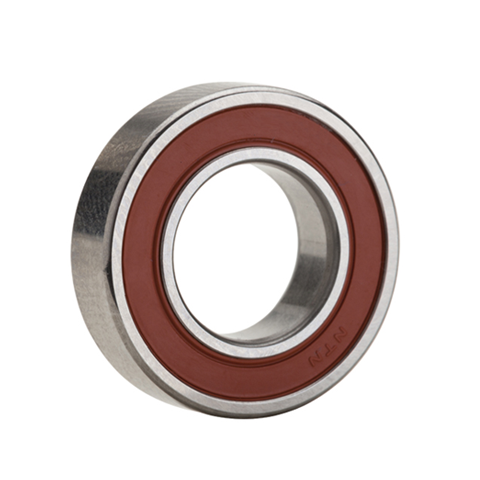
NTN NTN 6012LLU Deep Groove Ball Bearings , D=60
NTN 6012LLU Deep Groove Ball Bearings , D=60 SPECIFICATIONS Type of Product : Deep Groove Ball Bearing Model No : 6012LLU Width : 18 mm Inner Diameter : 60 mm 1. Design features and characteristics Deep groove ball bearings are very widely used. A deep groove is formed on the inner and outer ring of the bearing enabling the bearing to sustain radial and axial loads in either direction as well as the complex loads which result from the combination of these forces. Deep groove ball bearings are suitable for high speed applications. When two or more deep groove ball bearings are used in combination and mounted adjacent to each other a duplex set (D2) should be used. Duplex bearings (D2) utilize controlled tolerances to more evenly distribute the loading between the individual bearing rows which improves the overall performance of the assembly. In addition to unsealed and unlubricated “open” bearings, NTN provides deep groove ball bearings that are pre-lubricated with grease and enclosed by seals or shields. See section “11. Lubrication” for a list of some of the greases which can be used. Table 1 shows the construction and special characteristics of various sealed deep groove ball bearings. Types and codes N Shielded type Shielded type Non-contact type ZZ Non-contact type LLB Contact type LLU Low torque type LLH Construction Metal shield plate is affixed to the outside ring; the inner ring incorporates a V-groove and labyrinth clearance. The outer ring incorporates synthetic rubber molded to a steel plate; seal edge is aligned with V-groove along inner ring surface with labyrinth clearance The outer ring incorporates synthetic rubber molded to a steel plate; seal edge contacts V-groove along inner ring surface Basic construction is the same as LLU type, but a specially designed lip on the edge of the seal prevents foreign matter penetration; low torque construction. Torque Small Small Higher Medium Dust proofing Good Better than ZZ-type Excellent Much better than LLB-type Water proofing Poor Poor Very good Good High speed capacity Same as open type Same as open type Limited by contact seals Much better than LLU-type Allowable temp. range Depends on lubricant −25 to 120°C −25 to 110°C −25 to 120°C
$25.94
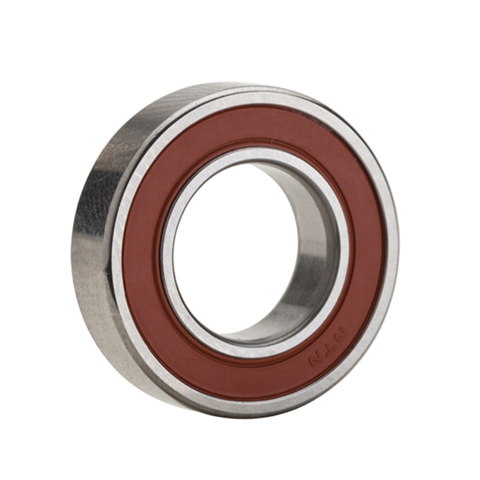
NTN NTN 6011LLUC3 Deep Groove Ball Bearings , D=55
NTN 6011LLUC3 Deep Groove Ball Bearings , D=55 SPECIFICATIONS Type of Product : Deep Groove Ball Bearing Model No : 6011LLUC3 Width : 18 mm Inner Diameter : 55 mm 1. Design features and characteristics Deep groove ball bearings are very widely used. A deep groove is formed on the inner and outer ring of the bearing enabling the bearing to sustain radial and axial loads in either direction as well as the complex loads which result from the combination of these forces. Deep groove ball bearings are suitable for high speed applications. When two or more deep groove ball bearings are used in combination and mounted adjacent to each other a duplex set (D2) should be used. Duplex bearings (D2) utilize controlled tolerances to more evenly distribute the loading between the individual bearing rows which improves the overall performance of the assembly. In addition to unsealed and unlubricated “open” bearings, NTN provides deep groove ball bearings that are pre-lubricated with grease and enclosed by seals or shields. See section “11. Lubrication” for a list of some of the greases which can be used. Table 1 shows the construction and special characteristics of various sealed deep groove ball bearings. Types and codes N Shielded type Shielded type Non-contact type ZZ Non-contact type LLB Contact type LLU Low torque type LLH Construction Metal shield plate is affixed to the outside ring; the inner ring incorporates a V-groove and labyrinth clearance. The outer ring incorporates synthetic rubber molded to a steel plate; seal edge is aligned with V-groove along inner ring surface with labyrinth clearance The outer ring incorporates synthetic rubber molded to a steel plate; seal edge contacts V-groove along inner ring surface Basic construction is the same as LLU type, but a specially designed lip on the edge of the seal prevents foreign matter penetration; low torque construction. Torque Small Small Higher Medium Dust proofing Good Better than ZZ-type Excellent Much better than LLB-type Water proofing Poor Poor Very good Good High speed capacity Same as open type Same as open type Limited by contact seals Much better than LLU-type Allowable temp. range Depends on lubricant −25 to 120°C −25 to 110°C −25 to 120°C
$21.90
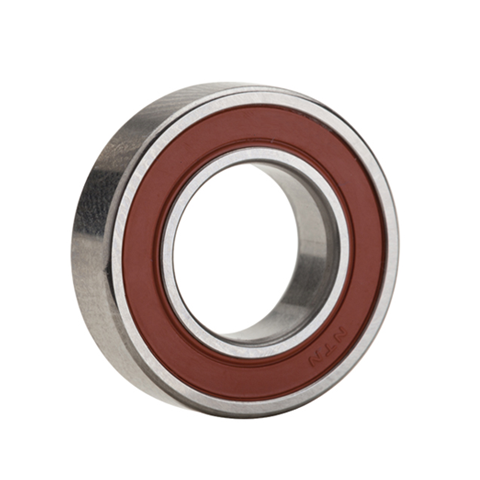
NTN NTN 6011LLU Deep Groove Ball Bearings , D=55
NTN 6011LLU Deep Groove Ball Bearings , D=55 SPECIFICATIONS Type of Product : Deep Groove Ball Bearing Model No : 6011LLU Width : 18 mm Inner Diameter : 55 mm 1. Design features and characteristics Deep groove ball bearings are very widely used. A deep groove is formed on the inner and outer ring of the bearing enabling the bearing to sustain radial and axial loads in either direction as well as the complex loads which result from the combination of these forces. Deep groove ball bearings are suitable for high speed applications. When two or more deep groove ball bearings are used in combination and mounted adjacent to each other a duplex set (D2) should be used. Duplex bearings (D2) utilize controlled tolerances to more evenly distribute the loading between the individual bearing rows which improves the overall performance of the assembly. In addition to unsealed and unlubricated “open” bearings, NTN provides deep groove ball bearings that are pre-lubricated with grease and enclosed by seals or shields. See section “11. Lubrication” for a list of some of the greases which can be used. Table 1 shows the construction and special characteristics of various sealed deep groove ball bearings. Types and codes N Shielded type Shielded type Non-contact type ZZ Non-contact type LLB Contact type LLU Low torque type LLH Construction Metal shield plate is affixed to the outside ring; the inner ring incorporates a V-groove and labyrinth clearance. The outer ring incorporates synthetic rubber molded to a steel plate; seal edge is aligned with V-groove along inner ring surface with labyrinth clearance The outer ring incorporates synthetic rubber molded to a steel plate; seal edge contacts V-groove along inner ring surface Basic construction is the same as LLU type, but a specially designed lip on the edge of the seal prevents foreign matter penetration; low torque construction. Torque Small Small Higher Medium Dust proofing Good Better than ZZ-type Excellent Much better than LLB-type Water proofing Poor Poor Very good Good High speed capacity Same as open type Same as open type Limited by contact seals Much better than LLU-type Allowable temp. range Depends on lubricant −25 to 120°C −25 to 110°C −25 to 120°C
$21.90
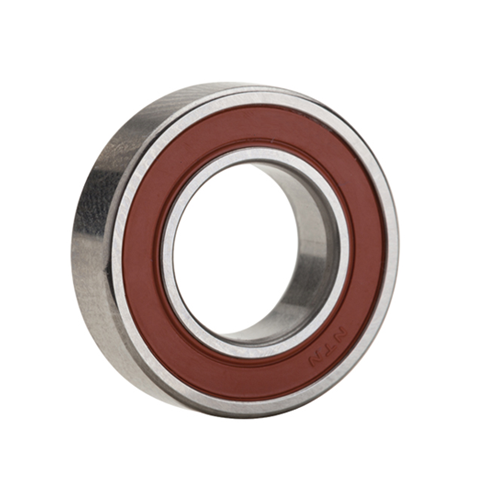
NTN NTN 6009LLUC3 Deep Groove Ball Bearings , D=45
NTN 6009LLUC3 Deep Groove Ball Bearings , D=45 SPECIFICATIONS Type of Product : Deep Groove Ball Bearing Model No : 6009LLUC3 Width : 16 mm Inner Diameter : 45 mm 1. Design features and characteristics Deep groove ball bearings are very widely used. A deep groove is formed on the inner and outer ring of the bearing enabling the bearing to sustain radial and axial loads in either direction as well as the complex loads which result from the combination of these forces. Deep groove ball bearings are suitable for high speed applications. When two or more deep groove ball bearings are used in combination and mounted adjacent to each other a duplex set (D2) should be used. Duplex bearings (D2) utilize controlled tolerances to more evenly distribute the loading between the individual bearing rows which improves the overall performance of the assembly. In addition to unsealed and unlubricated “open” bearings, NTN provides deep groove ball bearings that are pre-lubricated with grease and enclosed by seals or shields. See section “11. Lubrication” for a list of some of the greases which can be used. Table 1 shows the construction and special characteristics of various sealed deep groove ball bearings. Types and codes N Shielded type Shielded type Non-contact type ZZ Non-contact type LLB Contact type LLU Low torque type LLH Construction Metal shield plate is affixed to the outside ring; the inner ring incorporates a V-groove and labyrinth clearance. The outer ring incorporates synthetic rubber molded to a steel plate; seal edge is aligned with V-groove along inner ring surface with labyrinth clearance The outer ring incorporates synthetic rubber molded to a steel plate; seal edge contacts V-groove along inner ring surface Basic construction is the same as LLU type, but a specially designed lip on the edge of the seal prevents foreign matter penetration; low torque construction. Torque Small Small Higher Medium Dust proofing Good Better than ZZ-type Excellent Much better than LLB-type Water proofing Poor Poor Very good Good High speed capacity Same as open type Same as open type Limited by contact seals Much better than LLU-type Allowable temp. range Depends on lubricant −25 to 120°C −25 to 110°C −25 to 120°C
$14.70
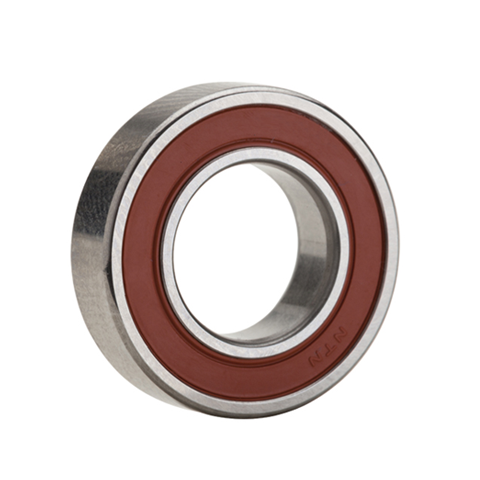
NTN NTN 6008LLU Deep Groove Ball Bearings , D=40
NTN 6008LLU Deep Groove Ball Bearings , D=40 SPECIFICATIONS Type of Product : Deep Groove Ball Bearing Model No : 6008LLU Width : 15 mm Inner Diameter : 40 mm 1. Design features and characteristics Deep groove ball bearings are very widely used. A deep groove is formed on the inner and outer ring of the bearing enabling the bearing to sustain radial and axial loads in either direction as well as the complex loads which result from the combination of these forces. Deep groove ball bearings are suitable for high speed applications. When two or more deep groove ball bearings are used in combination and mounted adjacent to each other a duplex set (D2) should be used. Duplex bearings (D2) utilize controlled tolerances to more evenly distribute the loading between the individual bearing rows which improves the overall performance of the assembly. In addition to unsealed and unlubricated “open” bearings, NTN provides deep groove ball bearings that are pre-lubricated with grease and enclosed by seals or shields. See section “11. Lubrication” for a list of some of the greases which can be used. Table 1 shows the construction and special characteristics of various sealed deep groove ball bearings. Types and codes N Shielded type Shielded type Non-contact type ZZ Non-contact type LLB Contact type LLU Low torque type LLH Construction Metal shield plate is affixed to the outside ring; the inner ring incorporates a V-groove and labyrinth clearance. The outer ring incorporates synthetic rubber molded to a steel plate; seal edge is aligned with V-groove along inner ring surface with labyrinth clearance The outer ring incorporates synthetic rubber molded to a steel plate; seal edge contacts V-groove along inner ring surface Basic construction is the same as LLU type, but a specially designed lip on the edge of the seal prevents foreign matter penetration; low torque construction. Torque Small Small Higher Medium Dust proofing Good Better than ZZ-type Excellent Much better than LLB-type Water proofing Poor Poor Very good Good High speed capacity Same as open type Same as open type Limited by contact seals Much better than LLU-type Allowable temp. range Depends on lubricant −25 to 120°C −25 to 110°C −25 to 120°C
$11.54
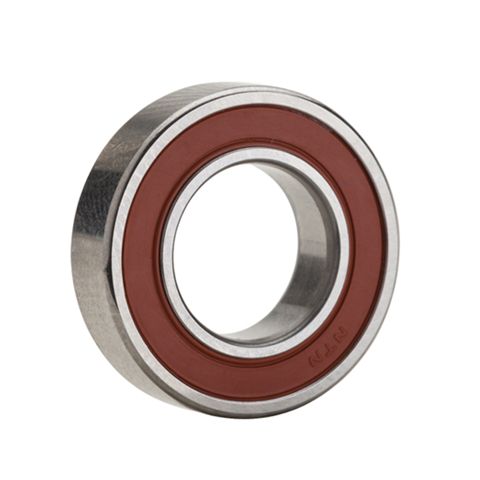
NTN NTN 6007LLUC3 Deep Groove Ball Bearings , D=35
NTN 6007LLUC3 Deep Groove Ball Bearings , D=35 SPECIFICATIONS Type of Product : Deep Groove Ball Bearing Model No : 6007LLUC3 Width : 14 mm Inner Diameter : 35 mm 1. Design features and characteristics Deep groove ball bearings are very widely used. A deep groove is formed on the inner and outer ring of the bearing enabling the bearing to sustain radial and axial loads in either direction as well as the complex loads which result from the combination of these forces. Deep groove ball bearings are suitable for high speed applications. When two or more deep groove ball bearings are used in combination and mounted adjacent to each other a duplex set (D2) should be used. Duplex bearings (D2) utilize controlled tolerances to more evenly distribute the loading between the individual bearing rows which improves the overall performance of the assembly. In addition to unsealed and unlubricated “open” bearings, NTN provides deep groove ball bearings that are pre-lubricated with grease and enclosed by seals or shields. See section “11. Lubrication” for a list of some of the greases which can be used. Table 1 shows the construction and special characteristics of various sealed deep groove ball bearings. Types and codes N Shielded type Shielded type Non-contact type ZZ Non-contact type LLB Contact type LLU Low torque type LLH Construction Metal shield plate is affixed to the outside ring; the inner ring incorporates a V-groove and labyrinth clearance. The outer ring incorporates synthetic rubber molded to a steel plate; seal edge is aligned with V-groove along inner ring surface with labyrinth clearance The outer ring incorporates synthetic rubber molded to a steel plate; seal edge contacts V-groove along inner ring surface Basic construction is the same as LLU type, but a specially designed lip on the edge of the seal prevents foreign matter penetration; low torque construction. Torque Small Small Higher Medium Dust proofing Good Better than ZZ-type Excellent Much better than LLB-type Water proofing Poor Poor Very good Good High speed capacity Same as open type Same as open type Limited by contact seals Much better than LLU-type Allowable temp. range Depends on lubricant −25 to 120°C −25 to 110°C −25 to 120°C
$8.48
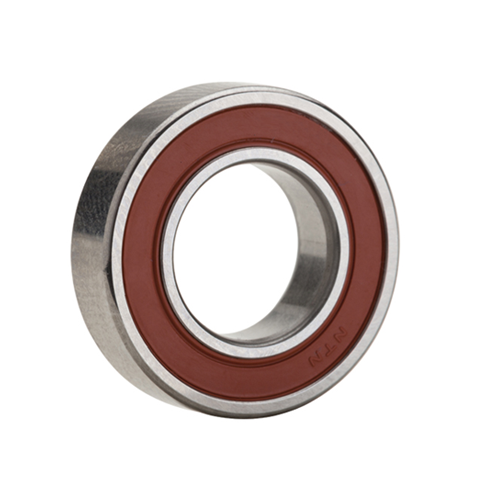
NTN NTN 6007LLU Deep Groove Ball Bearings , D=35
NTN 6007LLU Deep Groove Ball Bearings , D=35 SPECIFICATIONS Type of Product : Deep Groove Ball Bearing Model No : 6007LLU Width : 14 mm Inner Diameter : 35 mm 1. Design features and characteristics Deep groove ball bearings are very widely used. A deep groove is formed on the inner and outer ring of the bearing enabling the bearing to sustain radial and axial loads in either direction as well as the complex loads which result from the combination of these forces. Deep groove ball bearings are suitable for high speed applications. When two or more deep groove ball bearings are used in combination and mounted adjacent to each other a duplex set (D2) should be used. Duplex bearings (D2) utilize controlled tolerances to more evenly distribute the loading between the individual bearing rows which improves the overall performance of the assembly. In addition to unsealed and unlubricated “open” bearings, NTN provides deep groove ball bearings that are pre-lubricated with grease and enclosed by seals or shields. See section “11. Lubrication” for a list of some of the greases which can be used. Table 1 shows the construction and special characteristics of various sealed deep groove ball bearings. Types and codes N Shielded type Shielded type Non-contact type ZZ Non-contact type LLB Contact type LLU Low torque type LLH Construction Metal shield plate is affixed to the outside ring; the inner ring incorporates a V-groove and labyrinth clearance. The outer ring incorporates synthetic rubber molded to a steel plate; seal edge is aligned with V-groove along inner ring surface with labyrinth clearance The outer ring incorporates synthetic rubber molded to a steel plate; seal edge contacts V-groove along inner ring surface Basic construction is the same as LLU type, but a specially designed lip on the edge of the seal prevents foreign matter penetration; low torque construction. Torque Small Small Higher Medium Dust proofing Good Better than ZZ-type Excellent Much better than LLB-type Water proofing Poor Poor Very good Good High speed capacity Same as open type Same as open type Limited by contact seals Much better than LLU-type Allowable temp. range Depends on lubricant −25 to 120°C −25 to 110°C −25 to 120°C
$8.48
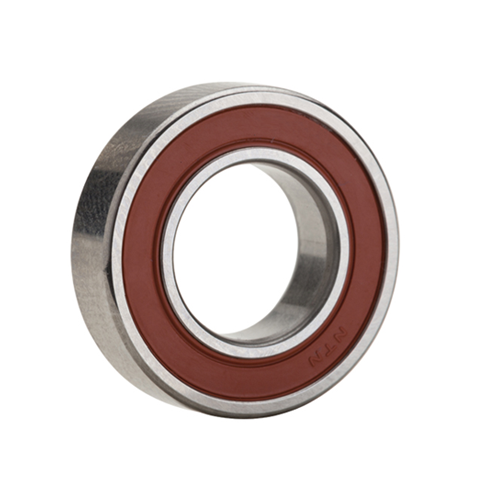
NTN NTN 6006LLUC3 Deep Groove Ball Bearings , D=30
NTN 6006LLUC3 Deep Groove Ball Bearings , D=30 SPECIFICATIONS Type of Product : Deep Groove Ball Bearing Model No : 6006LLUC3 Width : 13 mm Inner Diameter : 30 mm 1. Design features and characteristics Deep groove ball bearings are very widely used. A deep groove is formed on the inner and outer ring of the bearing enabling the bearing to sustain radial and axial loads in either direction as well as the complex loads which result from the combination of these forces. Deep groove ball bearings are suitable for high speed applications. When two or more deep groove ball bearings are used in combination and mounted adjacent to each other a duplex set (D2) should be used. Duplex bearings (D2) utilize controlled tolerances to more evenly distribute the loading between the individual bearing rows which improves the overall performance of the assembly. In addition to unsealed and unlubricated “open” bearings, NTN provides deep groove ball bearings that are pre-lubricated with grease and enclosed by seals or shields. See section “11. Lubrication” for a list of some of the greases which can be used. Table 1 shows the construction and special characteristics of various sealed deep groove ball bearings. Types and codes N Shielded type Shielded type Non-contact type ZZ Non-contact type LLB Contact type LLU Low torque type LLH Construction Metal shield plate is affixed to the outside ring; the inner ring incorporates a V-groove and labyrinth clearance. The outer ring incorporates synthetic rubber molded to a steel plate; seal edge is aligned with V-groove along inner ring surface with labyrinth clearance The outer ring incorporates synthetic rubber molded to a steel plate; seal edge contacts V-groove along inner ring surface Basic construction is the same as LLU type, but a specially designed lip on the edge of the seal prevents foreign matter penetration; low torque construction. Torque Small Small Higher Medium Dust proofing Good Better than ZZ-type Excellent Much better than LLB-type Water proofing Poor Poor Very good Good High speed capacity Same as open type Same as open type Limited by contact seals Much better than LLU-type Allowable temp. range Depends on lubricant −25 to 120°C −25 to 110°C −25 to 120°C
$6.72
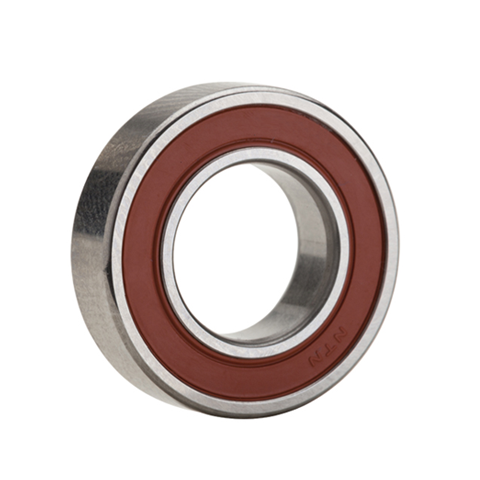
NTN NTN 6006LLU Deep Groove Ball Bearings , D=30
NTN 6006LLU Deep Groove Ball Bearings , D=30 SPECIFICATIONS Type of Product : Deep Groove Ball Bearing Model No : 6006LLU Width : 13 mm Inner Diameter : 30 mm 1. Design features and characteristics Deep groove ball bearings are very widely used. A deep groove is formed on the inner and outer ring of the bearing enabling the bearing to sustain radial and axial loads in either direction as well as the complex loads which result from the combination of these forces. Deep groove ball bearings are suitable for high speed applications. When two or more deep groove ball bearings are used in combination and mounted adjacent to each other a duplex set (D2) should be used. Duplex bearings (D2) utilize controlled tolerances to more evenly distribute the loading between the individual bearing rows which improves the overall performance of the assembly. In addition to unsealed and unlubricated “open” bearings, NTN provides deep groove ball bearings that are pre-lubricated with grease and enclosed by seals or shields. See section “11. Lubrication” for a list of some of the greases which can be used. Table 1 shows the construction and special characteristics of various sealed deep groove ball bearings. Types and codes N Shielded type Shielded type Non-contact type ZZ Non-contact type LLB Contact type LLU Low torque type LLH Construction Metal shield plate is affixed to the outside ring; the inner ring incorporates a V-groove and labyrinth clearance. The outer ring incorporates synthetic rubber molded to a steel plate; seal edge is aligned with V-groove along inner ring surface with labyrinth clearance The outer ring incorporates synthetic rubber molded to a steel plate; seal edge contacts V-groove along inner ring surface Basic construction is the same as LLU type, but a specially designed lip on the edge of the seal prevents foreign matter penetration; low torque construction. Torque Small Small Higher Medium Dust proofing Good Better than ZZ-type Excellent Much better than LLB-type Water proofing Poor Poor Very good Good High speed capacity Same as open type Same as open type Limited by contact seals Much better than LLU-type Allowable temp. range Depends on lubricant −25 to 120°C −25 to 110°C −25 to 120°C
$6.72
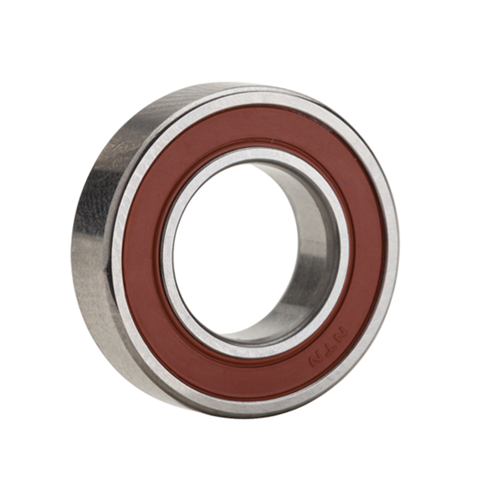
NTN NTN 6005LLUC3 Deep Groove Ball Bearings , D=25
NTN 6005LLUC3 Deep Groove Ball Bearings , D=25 SPECIFICATIONS Type of Product : Deep Groove Ball Bearing Model No : 6005LLUC3 Width : 12 mm Inner Diameter : 25 mm 1. Design features and characteristics Deep groove ball bearings are very widely used. A deep groove is formed on the inner and outer ring of the bearing enabling the bearing to sustain radial and axial loads in either direction as well as the complex loads which result from the combination of these forces. Deep groove ball bearings are suitable for high speed applications. When two or more deep groove ball bearings are used in combination and mounted adjacent to each other a duplex set (D2) should be used. Duplex bearings (D2) utilize controlled tolerances to more evenly distribute the loading between the individual bearing rows which improves the overall performance of the assembly. In addition to unsealed and unlubricated “open” bearings, NTN provides deep groove ball bearings that are pre-lubricated with grease and enclosed by seals or shields. See section “11. Lubrication” for a list of some of the greases which can be used. Table 1 shows the construction and special characteristics of various sealed deep groove ball bearings. Types and codes N Shielded type Shielded type Non-contact type ZZ Non-contact type LLB Contact type LLU Low torque type LLH Construction Metal shield plate is affixed to the outside ring; the inner ring incorporates a V-groove and labyrinth clearance. The outer ring incorporates synthetic rubber molded to a steel plate; seal edge is aligned with V-groove along inner ring surface with labyrinth clearance The outer ring incorporates synthetic rubber molded to a steel plate; seal edge contacts V-groove along inner ring surface Basic construction is the same as LLU type, but a specially designed lip on the edge of the seal prevents foreign matter penetration; low torque construction. Torque Small Small Higher Medium Dust proofing Good Better than ZZ-type Excellent Much better than LLB-type Water proofing Poor Poor Very good Good High speed capacity Same as open type Same as open type Limited by contact seals Much better than LLU-type Allowable temp. range Depends on lubricant −25 to 120°C −25 to 110°C −25 to 120°C
$5.60
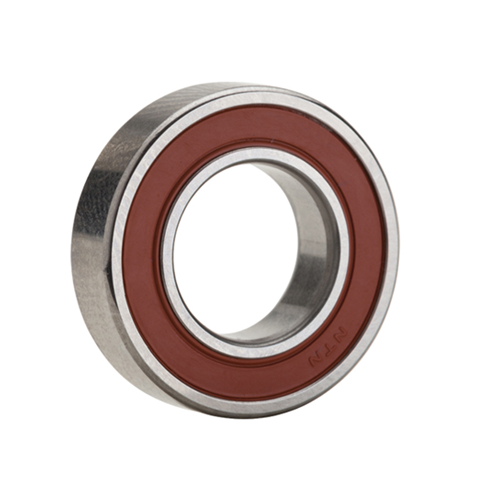
NTN NTN 6005LLU Deep Groove Ball Bearings , D=25
NTN 6005LLU Deep Groove Ball Bearings , D=25 SPECIFICATIONS Type of Product : Deep Groove Ball Bearing Model No : 6005LLU Width : 12 mm Inner Diameter : 25 mm 1. Design features and characteristics Deep groove ball bearings are very widely used. A deep groove is formed on the inner and outer ring of the bearing enabling the bearing to sustain radial and axial loads in either direction as well as the complex loads which result from the combination of these forces. Deep groove ball bearings are suitable for high speed applications. When two or more deep groove ball bearings are used in combination and mounted adjacent to each other a duplex set (D2) should be used. Duplex bearings (D2) utilize controlled tolerances to more evenly distribute the loading between the individual bearing rows which improves the overall performance of the assembly. In addition to unsealed and unlubricated “open” bearings, NTN provides deep groove ball bearings that are pre-lubricated with grease and enclosed by seals or shields. See section “11. Lubrication” for a list of some of the greases which can be used. Table 1 shows the construction and special characteristics of various sealed deep groove ball bearings. Types and codes N Shielded type Shielded type Non-contact type ZZ Non-contact type LLB Contact type LLU Low torque type LLH Construction Metal shield plate is affixed to the outside ring; the inner ring incorporates a V-groove and labyrinth clearance. The outer ring incorporates synthetic rubber molded to a steel plate; seal edge is aligned with V-groove along inner ring surface with labyrinth clearance The outer ring incorporates synthetic rubber molded to a steel plate; seal edge contacts V-groove along inner ring surface Basic construction is the same as LLU type, but a specially designed lip on the edge of the seal prevents foreign matter penetration; low torque construction. Torque Small Small Higher Medium Dust proofing Good Better than ZZ-type Excellent Much better than LLB-type Water proofing Poor Poor Very good Good High speed capacity Same as open type Same as open type Limited by contact seals Much better than LLU-type Allowable temp. range Depends on lubricant −25 to 120°C −25 to 110°C −25 to 120°C
$5.60
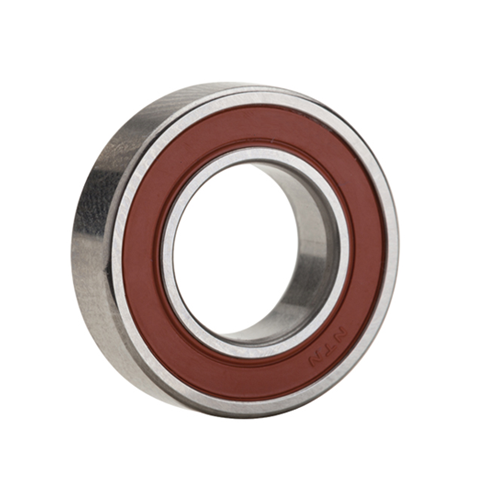
NTN NTN 6004LLU Deep Groove Ball Bearings , D=20
NTN 6004LLU Deep Groove Ball Bearings , D=20 SPECIFICATIONS Type of Product : Deep Groove Ball Bearing Model No : 6004LLU Width : 12 mm Inner Diameter : 20 mm 1. Design features and characteristics Deep groove ball bearings are very widely used. A deep groove is formed on the inner and outer ring of the bearing enabling the bearing to sustain radial and axial loads in either direction as well as the complex loads which result from the combination of these forces. Deep groove ball bearings are suitable for high speed applications. When two or more deep groove ball bearings are used in combination and mounted adjacent to each other a duplex set (D2) should be used. Duplex bearings (D2) utilize controlled tolerances to more evenly distribute the loading between the individual bearing rows which improves the overall performance of the assembly. In addition to unsealed and unlubricated “open” bearings, NTN provides deep groove ball bearings that are pre-lubricated with grease and enclosed by seals or shields. See section “11. Lubrication” for a list of some of the greases which can be used. Table 1 shows the construction and special characteristics of various sealed deep groove ball bearings. Types and codes N Shielded type Shielded type Non-contact type ZZ Non-contact type LLB Contact type LLU Low torque type LLH Construction Metal shield plate is affixed to the outside ring; the inner ring incorporates a V-groove and labyrinth clearance. The outer ring incorporates synthetic rubber molded to a steel plate; seal edge is aligned with V-groove along inner ring surface with labyrinth clearance The outer ring incorporates synthetic rubber molded to a steel plate; seal edge contacts V-groove along inner ring surface Basic construction is the same as LLU type, but a specially designed lip on the edge of the seal prevents foreign matter penetration; low torque construction. Torque Small Small Higher Medium Dust proofing Good Better than ZZ-type Excellent Much better than LLB-type Water proofing Poor Poor Very good Good High speed capacity Same as open type Same as open type Limited by contact seals Much better than LLU-type Allowable temp. range Depends on lubricant −25 to 120°C −25 to 110°C −25 to 120°C
$4.76
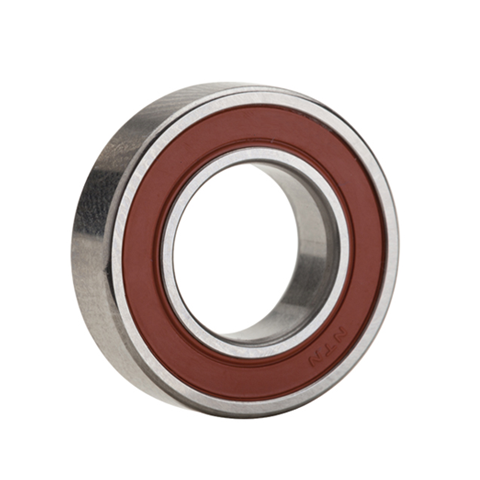
NTN NTN 6003LLUC3 Deep Groove Ball Bearings , D=17
NTN 6003LLUC3 Deep Groove Ball Bearings , D=17 SPECIFICATIONS Type of Product : Deep Groove Ball Bearing Model No : 6003LLUC3 Width : 10 mm Inner Diameter : 17 mm 1. Design features and characteristics Deep groove ball bearings are very widely used. A deep groove is formed on the inner and outer ring of the bearing enabling the bearing to sustain radial and axial loads in either direction as well as the complex loads which result from the combination of these forces. Deep groove ball bearings are suitable for high speed applications. When two or more deep groove ball bearings are used in combination and mounted adjacent to each other a duplex set (D2) should be used. Duplex bearings (D2) utilize controlled tolerances to more evenly distribute the loading between the individual bearing rows which improves the overall performance of the assembly. In addition to unsealed and unlubricated “open” bearings, NTN provides deep groove ball bearings that are pre-lubricated with grease and enclosed by seals or shields. See section “11. Lubrication” for a list of some of the greases which can be used. Table 1 shows the construction and special characteristics of various sealed deep groove ball bearings. Types and codes N Shielded type Shielded type Non-contact type ZZ Non-contact type LLB Contact type LLU Low torque type LLH Construction Metal shield plate is affixed to the outside ring; the inner ring incorporates a V-groove and labyrinth clearance. The outer ring incorporates synthetic rubber molded to a steel plate; seal edge is aligned with V-groove along inner ring surface with labyrinth clearance The outer ring incorporates synthetic rubber molded to a steel plate; seal edge contacts V-groove along inner ring surface Basic construction is the same as LLU type, but a specially designed lip on the edge of the seal prevents foreign matter penetration; low torque construction. Torque Small Small Higher Medium Dust proofing Good Better than ZZ-type Excellent Much better than LLB-type Water proofing Poor Poor Very good Good High speed capacity Same as open type Same as open type Limited by contact seals Much better than LLU-type Allowable temp. range Depends on lubricant −25 to 120°C −25 to 110°C −25 to 120°C
$3.70
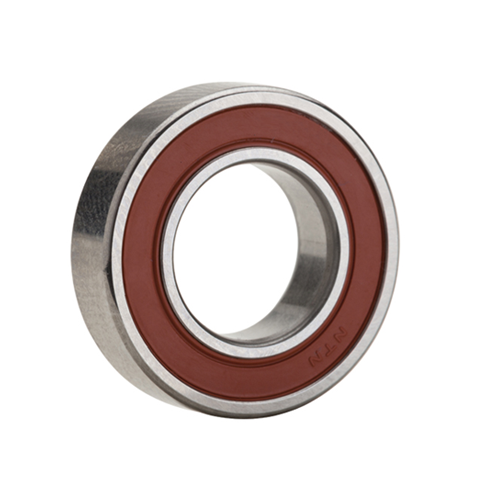
NTN NTN 6002LLUC3 Deep Groove Ball Bearings , D=15
NTN 6002LLUC3 Deep Groove Ball Bearings , D=15 SPECIFICATIONS Type of Product : Deep Groove Ball Bearing Model No : 6002LLUC3 Width : 9 mm Inner Diameter : 15 mm 1. Design features and characteristics Deep groove ball bearings are very widely used. A deep groove is formed on the inner and outer ring of the bearing enabling the bearing to sustain radial and axial loads in either direction as well as the complex loads which result from the combination of these forces. Deep groove ball bearings are suitable for high speed applications. When two or more deep groove ball bearings are used in combination and mounted adjacent to each other a duplex set (D2) should be used. Duplex bearings (D2) utilize controlled tolerances to more evenly distribute the loading between the individual bearing rows which improves the overall performance of the assembly. In addition to unsealed and unlubricated “open” bearings, NTN provides deep groove ball bearings that are pre-lubricated with grease and enclosed by seals or shields. See section “11. Lubrication” for a list of some of the greases which can be used. Table 1 shows the construction and special characteristics of various sealed deep groove ball bearings. Types and codes N Shielded type Shielded type Non-contact type ZZ Non-contact type LLB Contact type LLU Low torque type LLH Construction Metal shield plate is affixed to the outside ring; the inner ring incorporates a V-groove and labyrinth clearance. The outer ring incorporates synthetic rubber molded to a steel plate; seal edge is aligned with V-groove along inner ring surface with labyrinth clearance The outer ring incorporates synthetic rubber molded to a steel plate; seal edge contacts V-groove along inner ring surface Basic construction is the same as LLU type, but a specially designed lip on the edge of the seal prevents foreign matter penetration; low torque construction. Torque Small Small Higher Medium Dust proofing Good Better than ZZ-type Excellent Much better than LLB-type Water proofing Poor Poor Very good Good High speed capacity Same as open type Same as open type Limited by contact seals Much better than LLU-type Allowable temp. range Depends on lubricant −25 to 120°C −25 to 110°C −25 to 120°C
$3.64
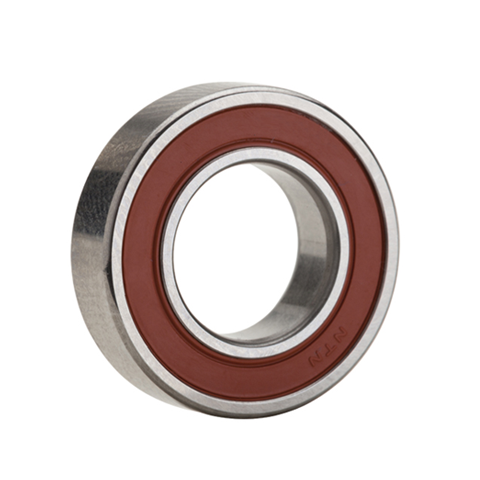
NTN NTN 6002LLU Deep Groove Ball Bearings , D=15
NTN 6002LLU Deep Groove Ball Bearings , D=15 SPECIFICATIONS Type of Product : Deep Groove Ball Bearing Model No : 6002LLU Width : 9 mm Inner Diameter : 15 mm 1. Design features and characteristics Deep groove ball bearings are very widely used. A deep groove is formed on the inner and outer ring of the bearing enabling the bearing to sustain radial and axial loads in either direction as well as the complex loads which result from the combination of these forces. Deep groove ball bearings are suitable for high speed applications. When two or more deep groove ball bearings are used in combination and mounted adjacent to each other a duplex set (D2) should be used. Duplex bearings (D2) utilize controlled tolerances to more evenly distribute the loading between the individual bearing rows which improves the overall performance of the assembly. In addition to unsealed and unlubricated “open” bearings, NTN provides deep groove ball bearings that are pre-lubricated with grease and enclosed by seals or shields. See section “11. Lubrication” for a list of some of the greases which can be used. Table 1 shows the construction and special characteristics of various sealed deep groove ball bearings. Types and codes N Shielded type Shielded type Non-contact type ZZ Non-contact type LLB Contact type LLU Low torque type LLH Construction Metal shield plate is affixed to the outside ring; the inner ring incorporates a V-groove and labyrinth clearance. The outer ring incorporates synthetic rubber molded to a steel plate; seal edge is aligned with V-groove along inner ring surface with labyrinth clearance The outer ring incorporates synthetic rubber molded to a steel plate; seal edge contacts V-groove along inner ring surface Basic construction is the same as LLU type, but a specially designed lip on the edge of the seal prevents foreign matter penetration; low torque construction. Torque Small Small Higher Medium Dust proofing Good Better than ZZ-type Excellent Much better than LLB-type Water proofing Poor Poor Very good Good High speed capacity Same as open type Same as open type Limited by contact seals Much better than LLU-type Allowable temp. range Depends on lubricant −25 to 120°C −25 to 110°C −25 to 120°C
$3.64
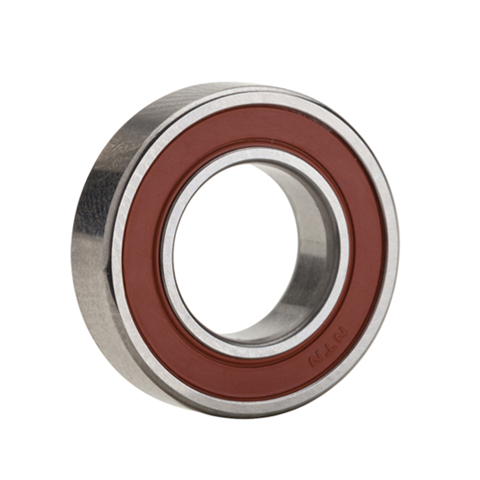
NTN NTN 6001LLUC3 Deep Groove Ball Bearings , D=12
NTN 6001LLUC3 Deep Groove Ball Bearings , D=12 SPECIFICATIONS Type of Product : Deep Groove Ball Bearing Model No : 6001LLUC3 Width : 8 mm Inner Diameter : 12 mm 1. Design features and characteristics Deep groove ball bearings are very widely used. A deep groove is formed on the inner and outer ring of the bearing enabling the bearing to sustain radial and axial loads in either direction as well as the complex loads which result from the combination of these forces. Deep groove ball bearings are suitable for high speed applications. When two or more deep groove ball bearings are used in combination and mounted adjacent to each other a duplex set (D2) should be used. Duplex bearings (D2) utilize controlled tolerances to more evenly distribute the loading between the individual bearing rows which improves the overall performance of the assembly. In addition to unsealed and unlubricated “open” bearings, NTN provides deep groove ball bearings that are pre-lubricated with grease and enclosed by seals or shields. See section “11. Lubrication” for a list of some of the greases which can be used. Table 1 shows the construction and special characteristics of various sealed deep groove ball bearings. Types and codes N Shielded type Shielded type Non-contact type ZZ Non-contact type LLB Contact type LLU Low torque type LLH Construction Metal shield plate is affixed to the outside ring; the inner ring incorporates a V-groove and labyrinth clearance. The outer ring incorporates synthetic rubber molded to a steel plate; seal edge is aligned with V-groove along inner ring surface with labyrinth clearance The outer ring incorporates synthetic rubber molded to a steel plate; seal edge contacts V-groove along inner ring surface Basic construction is the same as LLU type, but a specially designed lip on the edge of the seal prevents foreign matter penetration; low torque construction. Torque Small Small Higher Medium Dust proofing Good Better than ZZ-type Excellent Much better than LLB-type Water proofing Poor Poor Very good Good High speed capacity Same as open type Same as open type Limited by contact seals Much better than LLU-type Allowable temp. range Depends on lubricant −25 to 120°C −25 to 110°C −25 to 120°C
$3.12
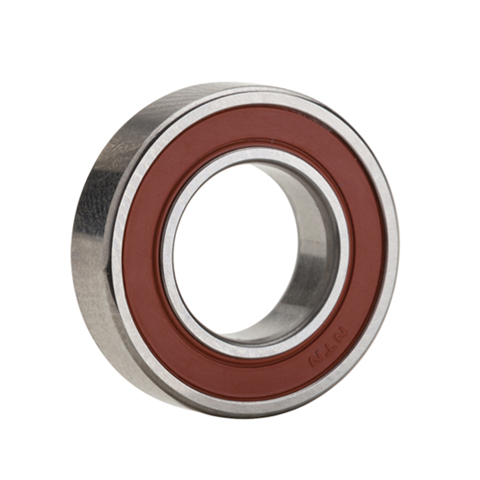
NTN NTN 6001LLU Deep Groove Ball Bearings , D=12
NTN 6001LLU Deep Groove Ball Bearings , D=12 SPECIFICATIONS Type of Product : Deep Groove Ball Bearing Model No : 6001LLU Width : 8 mm Inner Diameter : 12 mm 1. Design features and characteristics Deep groove ball bearings are very widely used. A deep groove is formed on the inner and outer ring of the bearing enabling the bearing to sustain radial and axial loads in either direction as well as the complex loads which result from the combination of these forces. Deep groove ball bearings are suitable for high speed applications. When two or more deep groove ball bearings are used in combination and mounted adjacent to each other a duplex set (D2) should be used. Duplex bearings (D2) utilize controlled tolerances to more evenly distribute the loading between the individual bearing rows which improves the overall performance of the assembly. In addition to unsealed and unlubricated “open” bearings, NTN provides deep groove ball bearings that are pre-lubricated with grease and enclosed by seals or shields. See section “11. Lubrication” for a list of some of the greases which can be used. Table 1 shows the construction and special characteristics of various sealed deep groove ball bearings. Types and codes N Shielded type Shielded type Non-contact type ZZ Non-contact type LLB Contact type LLU Low torque type LLH Construction Metal shield plate is affixed to the outside ring; the inner ring incorporates a V-groove and labyrinth clearance. The outer ring incorporates synthetic rubber molded to a steel plate; seal edge is aligned with V-groove along inner ring surface with labyrinth clearance The outer ring incorporates synthetic rubber molded to a steel plate; seal edge contacts V-groove along inner ring surface Basic construction is the same as LLU type, but a specially designed lip on the edge of the seal prevents foreign matter penetration; low torque construction. Torque Small Small Higher Medium Dust proofing Good Better than ZZ-type Excellent Much better than LLB-type Water proofing Poor Poor Very good Good High speed capacity Same as open type Same as open type Limited by contact seals Much better than LLU-type Allowable temp. range Depends on lubricant −25 to 120°C −25 to 110°C −25 to 120°C
$3.12
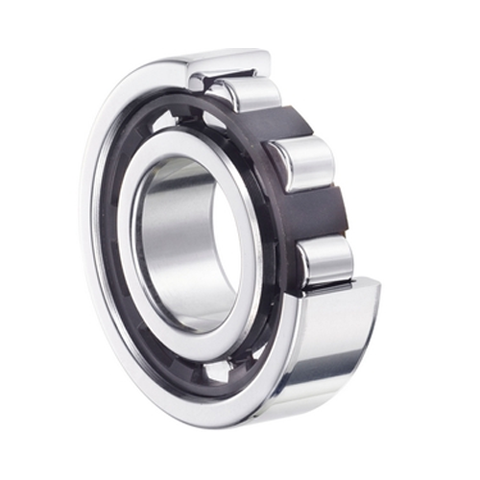
NTN NTN NF204 Cylindrical Roller Bearing - D=20
NTN Inner Dia 20 mm Cylindrical Roller Bearing Single Row NF204 Features Type of Product : Cylindrical Roller Bearing Single Row Inner Diameter : 20 mm Model No : NF204 Width : 14 mm 1. Types, design features, and characteristics Cylindrical roller bearings can accommodate heavy radial loads due to the line contact formed between their rolling elements and raceways. These bearings are also suitable for high speed applications since the rollers are guided by either inner or outer ring ribs. Cylindrical roller bearings are separable, allowing them to be easily installed and disassembled even when interference fits are required.Among the various types of cylindrical roller bearings, E type and EA type have a high load capacity while maintaining standard boundary dimensions. HT type has a large axial load capacity, and HL type provides extended fatigue life in poor lubrication conditions. Multiple row bearing arrangements are also available.For extremely heavy load applications, the non-separable full complement SL type bearing offers special advantages. For SL type and four- row cylindrical roller bearings, see section “C. Special application bearings.”Table 1 shows the various types and characteristics of single row cylindrical roller bearings. Table 2 shows the characteristics of non-standard type cylindrical roller bearings. Table 1 Cylindrical roller bearing types and characteristics Type code Design Characteristics NU type N type -NU type outer rings have two ribs. The outer ring, roller, and cage assembly can be separated from the inner ring. N type inner rings have two ribs. The inner ring, roller, and cage assembly can be separated from the outer ring.-Unable to accommodate any axial loading. -This is widely used as the floating side bearing in a fixed-float arrangement. NJ type NF type -NJ type has two ribs on the outer ring, a single rib on the inner ring; NF type has a single rib on the outer ring, and two ribs on the inner ring.-Can receive single direction axial loads. -When there is no distinction between the fixed side and floating side bearing, these types can be used as a pair in close proximity. NUP type NH type (NJ+HJ) -NUP type has a collar ring attached to the ribless side of the inner ring; NH type is NJ type with an L type collar ring attached. All of these collar rings are separable, and therefore it is necessary to fix the inner ring axially. -Can accommodate axial loads in either direction. -Widely used as the shaft’s fixed-side bearing Table 2 Non-standard type cylindrical roller bearing characteristics Designation Characteristics E type and EA type Cylindrical roller bearing -Boundary dimensions are the same as the standard type, but the diameter, length and number of the rollers have been increased, resulting in higher load capacity. -Identified by the addition of “E” to the end of the basic roller number. -Enables compact design due increased load rating. -Rollers’ inscribed circle diameter differs from the standard type rollers and therefore cannot be interchanged. -EA type bearings are ULTAGE series1). Note: In the dimension tables, both E type and EA type are listed. Cylindrical roller bearing for axial loads (HT type) -Can accommodate larger axial loads than the standard type due to improved geometry of the rib roller end surface. -Please consult NTN Engineering concerning necessary considerations, such as load, lubricant, and installation conditions. Double-row cylindrical roller bearing -NN type and NNU type are available. -Widely used for applications requiring thin-walled bearings, such the main shafts of machine tools, rolling machine rollers, and in printing equipment. -Internal radial clearance is adjusted for the spindle of machine tools by pressing the tapered bore of the inner ring on a tapered shaft. Remarks: For precision bearings for machine tools, see precision rolling bearings 2. Standard cage type Table 3 shows the standard cage types for cylindrical roller bearings. The basic load ratings listed in the dimension charts correspond to use of the standard cages listed in Table 3. The basic load ratings listed in the dimension tables are for standard configurations. These ratings can change when a different cage type and number of rolling elements is utilized. Note: 1. Within the same bearing series, cage type is constant regardless of the cylindrical roller bearing type (NJ, NUP, N, NF).2. For high speed and other special applications, machined cages can be manufactured when necessary. Consult NTN Engineering.3. Among EA type bearings that use resin cages as standard, certain varieties use pressed cages. Consult NTN Engineering.4. Although machined cages are the standard for two-row cylindrical roller bearings, resin cages may also be used in some of these bearings for machine tool applications.
$13.20
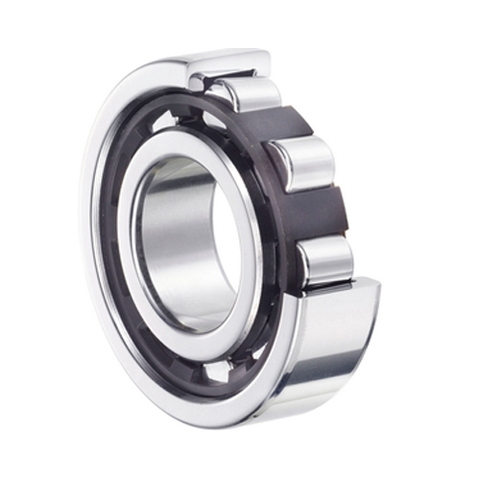
NTN NTN N312C3 Cylindrical Roller Bearing - D=60
NTN N312C3 Cylindrical Roller Bearing (Inside Dia - 60mm, Outside Dia - 130mm) Features Type of Product : Cylindrical Roller Bearing Inside Diameter (d) (mm) : 60 Outside Diameter D (mm) : 130 Width Dia mm : 31 Model No : N312C3 1. Types, design features, and characteristics Cylindrical roller bearings can accommodate heavy radial loads due to the line contact formed between their rolling elements and raceways. These bearings are also suitable for high speed applications since the rollers are guided by either inner or outer ring ribs. Cylindrical roller bearings are separable, allowing them to be easily installed and disassembled even when interference fits are required.Among the various types of cylindrical roller bearings, E type and EA type have a high load capacity while maintaining standard boundary dimensions. HT type has a large axial load capacity, and HL type provides extended fatigue life in poor lubrication conditions. Multiple row bearing arrangements are also available.For extremely heavy load applications, the non-separable full complement SL type bearing offers special advantages. For SL type and four- row cylindrical roller bearings, see section “C. Special application bearings.”Table 1 shows the various types and characteristics of single row cylindrical roller bearings. Table 2 shows the characteristics of non-standard type cylindrical roller bearings. Table 1 Cylindrical roller bearing types and characteristics Type code Design Characteristics NU type N type -NU type outer rings have two ribs. The outer ring, roller, and cage assembly can be separated from the inner ring. N type inner rings have two ribs. The inner ring, roller, and cage assembly can be separated from the outer ring.-Unable to accommodate any axial loading. -This is widely used as the floating side bearing in a fixed-float arrangement. NJ type NF type -NJ type has two ribs on the outer ring, a single rib on the inner ring; NF type has a single rib on the outer ring, and two ribs on the inner ring.-Can receive single direction axial loads. -When there is no distinction between the fixed side and floating side bearing, these types can be used as a pair in close proximity. NUP type NH type (NJ+HJ) -NUP type has a collar ring attached to the ribless side of the inner ring; NH type is NJ type with an L type collar ring attached. All of these collar rings are separable, and therefore it is necessary to fix the inner ring axially. -Can accommodate axial loads in either direction. -Widely used as the shaft’s fixed-side bearing Table 2 Non-standard type cylindrical roller bearing characteristics Designation Characteristics E type and EA type Cylindrical roller bearing -Boundary dimensions are the same as the standard type, but the diameter, length and number of the rollers have been increased, resulting in higher load capacity. -Identified by the addition of “E” to the end of the basic roller number. -Enables compact design due increased load rating. -Rollers’ inscribed circle diameter differs from the standard type rollers and therefore cannot be interchanged. -EA type bearings are ULTAGE series1). Note: In the dimension tables, both E type and EA type are listed. Cylindrical roller bearing for axial loads (HT type) -Can accommodate larger axial loads than the standard type due to improved geometry of the rib roller end surface. -Please consult NTN Engineering concerning necessary considerations, such as load, lubricant, and installation conditions. Double-row cylindrical roller bearing -NN type and NNU type are available. -Widely used for applications requiring thin-walled bearings, such the main shafts of machine tools, rolling machine rollers, and in printing equipment. -Internal radial clearance is adjusted for the spindle of machine tools by pressing the tapered bore of the inner ring on a tapered shaft. Remarks: For precision bearings for machine tools, see precision rolling bearings 2. Standard cage type Table 3 shows the standard cage types for cylindrical roller bearings. The basic load ratings listed in the dimension charts correspond to use of the standard cages listed in Table 3. The basic load ratings listed in the dimension tables are for standard configurations. These ratings can change when a different cage type and number of rolling elements is utilized. Note: 1. Within the same bearing series, cage type is constant regardless of the cylindrical roller bearing type (NJ, NUP, N, NF).2. For high speed and other special applications, machined cages can be manufactured when necessary. Consult NTN Engineering.3. Among EA type bearings that use resin cages as standard, certain varieties use pressed cages. Consult NTN Engineering.4. Although machined cages are the standard for two-row cylindrical roller bearings, resin cages may also be used in some of these bearings for machine tool applications.
$65.99
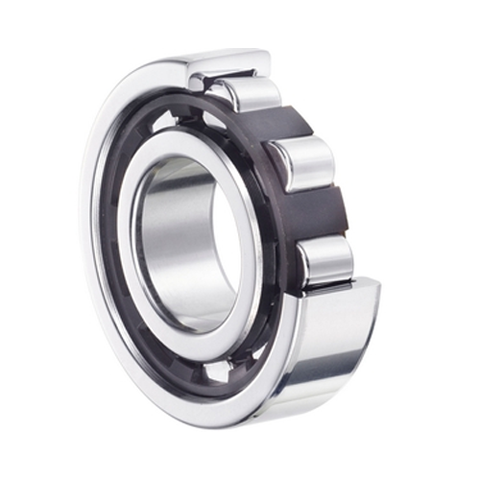
NTN NTN N308 Cylindrical Roller Bearing - D=40
NTN N308 Cylindrical Roller Bearing (Inside Dia - 40mm, Outside Dia - 90mm) Features Type of Product : Cylindrical Roller Bearing Inside Diameter (d) (mm) : 40 Outside Diameter D (mm) : 90 Width Dia mm : 23 Model No : N308 1. Types, design features, and characteristics Cylindrical roller bearings can accommodate heavy radial loads due to the line contact formed between their rolling elements and raceways. These bearings are also suitable for high speed applications since the rollers are guided by either inner or outer ring ribs. Cylindrical roller bearings are separable, allowing them to be easily installed and disassembled even when interference fits are required.Among the various types of cylindrical roller bearings, E type and EA type have a high load capacity while maintaining standard boundary dimensions. HT type has a large axial load capacity, and HL type provides extended fatigue life in poor lubrication conditions. Multiple row bearing arrangements are also available.For extremely heavy load applications, the non-separable full complement SL type bearing offers special advantages. For SL type and four- row cylindrical roller bearings, see section “C. Special application bearings.”Table 1 shows the various types and characteristics of single row cylindrical roller bearings. Table 2 shows the characteristics of non-standard type cylindrical roller bearings. Table 1 Cylindrical roller bearing types and characteristics Type code Design Characteristics NU type N type -NU type outer rings have two ribs. The outer ring, roller, and cage assembly can be separated from the inner ring. N type inner rings have two ribs. The inner ring, roller, and cage assembly can be separated from the outer ring.-Unable to accommodate any axial loading. -This is widely used as the floating side bearing in a fixed-float arrangement. NJ type NF type -NJ type has two ribs on the outer ring, a single rib on the inner ring; NF type has a single rib on the outer ring, and two ribs on the inner ring.-Can receive single direction axial loads. -When there is no distinction between the fixed side and floating side bearing, these types can be used as a pair in close proximity. NUP type NH type (NJ+HJ) -NUP type has a collar ring attached to the ribless side of the inner ring; NH type is NJ type with an L type collar ring attached. All of these collar rings are separable, and therefore it is necessary to fix the inner ring axially. -Can accommodate axial loads in either direction. -Widely used as the shaft’s fixed-side bearing Table 2 Non-standard type cylindrical roller bearing characteristics Designation Characteristics E type and EA type Cylindrical roller bearing -Boundary dimensions are the same as the standard type, but the diameter, length and number of the rollers have been increased, resulting in higher load capacity. -Identified by the addition of “E” to the end of the basic roller number. -Enables compact design due increased load rating. -Rollers’ inscribed circle diameter differs from the standard type rollers and therefore cannot be interchanged. -EA type bearings are ULTAGE series1). Note: In the dimension tables, both E type and EA type are listed. Cylindrical roller bearing for axial loads (HT type) -Can accommodate larger axial loads than the standard type due to improved geometry of the rib roller end surface. -Please consult NTN Engineering concerning necessary considerations, such as load, lubricant, and installation conditions. Double-row cylindrical roller bearing -NN type and NNU type are available. -Widely used for applications requiring thin-walled bearings, such the main shafts of machine tools, rolling machine rollers, and in printing equipment. -Internal radial clearance is adjusted for the spindle of machine tools by pressing the tapered bore of the inner ring on a tapered shaft. Remarks: For precision bearings for machine tools, see precision rolling bearings 2. Standard cage type Table 3 shows the standard cage types for cylindrical roller bearings. The basic load ratings listed in the dimension charts correspond to use of the standard cages listed in Table 3. The basic load ratings listed in the dimension tables are for standard configurations. These ratings can change when a different cage type and number of rolling elements is utilized. Note: 1. Within the same bearing series, cage type is constant regardless of the cylindrical roller bearing type (NJ, NUP, N, NF).2. For high speed and other special applications, machined cages can be manufactured when necessary. Consult NTN Engineering.3. Among EA type bearings that use resin cages as standard, certain varieties use pressed cages. Consult NTN Engineering.4. Although machined cages are the standard for two-row cylindrical roller bearings, resin cages may also be used in some of these bearings for machine tool applications.
$33.24
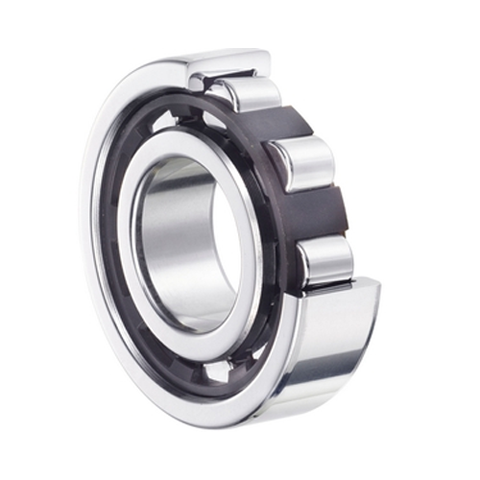
NTN NTN N217 Cylindrical Roller Bearing - D=85
NTN N217 Cylindrical Roller Bearing (Inside Dia - 85mm, Outside Dia - 150mm) Features Type of Product : Cylindrical Roller Bearing Inside Diameter (d) (mm) : 85 Outside Diameter D (mm) : 150 Width Dia mm : 28 Model No : N217 1. Types, design features, and characteristics Cylindrical roller bearings can accommodate heavy radial loads due to the line contact formed between their rolling elements and raceways. These bearings are also suitable for high speed applications since the rollers are guided by either inner or outer ring ribs. Cylindrical roller bearings are separable, allowing them to be easily installed and disassembled even when interference fits are required.Among the various types of cylindrical roller bearings, E type and EA type have a high load capacity while maintaining standard boundary dimensions. HT type has a large axial load capacity, and HL type provides extended fatigue life in poor lubrication conditions. Multiple row bearing arrangements are also available.For extremely heavy load applications, the non-separable full complement SL type bearing offers special advantages. For SL type and four- row cylindrical roller bearings, see section “C. Special application bearings.”Table 1 shows the various types and characteristics of single row cylindrical roller bearings. Table 2 shows the characteristics of non-standard type cylindrical roller bearings. Table 1 Cylindrical roller bearing types and characteristics Type code Design Characteristics NU type N type -NU type outer rings have two ribs. The outer ring, roller, and cage assembly can be separated from the inner ring. N type inner rings have two ribs. The inner ring, roller, and cage assembly can be separated from the outer ring.-Unable to accommodate any axial loading. -This is widely used as the floating side bearing in a fixed-float arrangement. NJ type NF type -NJ type has two ribs on the outer ring, a single rib on the inner ring; NF type has a single rib on the outer ring, and two ribs on the inner ring.-Can receive single direction axial loads. -When there is no distinction between the fixed side and floating side bearing, these types can be used as a pair in close proximity. NUP type NH type (NJ+HJ) -NUP type has a collar ring attached to the ribless side of the inner ring; NH type is NJ type with an L type collar ring attached. All of these collar rings are separable, and therefore it is necessary to fix the inner ring axially. -Can accommodate axial loads in either direction. -Widely used as the shaft’s fixed-side bearing Table 2 Non-standard type cylindrical roller bearing characteristics Designation Characteristics E type and EA type Cylindrical roller bearing -Boundary dimensions are the same as the standard type, but the diameter, length and number of the rollers have been increased, resulting in higher load capacity. -Identified by the addition of “E” to the end of the basic roller number. -Enables compact design due increased load rating. -Rollers’ inscribed circle diameter differs from the standard type rollers and therefore cannot be interchanged. -EA type bearings are ULTAGE series1). Note: In the dimension tables, both E type and EA type are listed. Cylindrical roller bearing for axial loads (HT type) -Can accommodate larger axial loads than the standard type due to improved geometry of the rib roller end surface. -Please consult NTN Engineering concerning necessary considerations, such as load, lubricant, and installation conditions. Double-row cylindrical roller bearing -NN type and NNU type are available. -Widely used for applications requiring thin-walled bearings, such the main shafts of machine tools, rolling machine rollers, and in printing equipment. -Internal radial clearance is adjusted for the spindle of machine tools by pressing the tapered bore of the inner ring on a tapered shaft. Remarks: For precision bearings for machine tools, see precision rolling bearings 2. Standard cage type Table 3 shows the standard cage types for cylindrical roller bearings. The basic load ratings listed in the dimension charts correspond to use of the standard cages listed in Table 3. The basic load ratings listed in the dimension tables are for standard configurations. These ratings can change when a different cage type and number of rolling elements is utilized. Note: 1. Within the same bearing series, cage type is constant regardless of the cylindrical roller bearing type (NJ, NUP, N, NF).2. For high speed and other special applications, machined cages can be manufactured when necessary. Consult NTN Engineering.3. Among EA type bearings that use resin cages as standard, certain varieties use pressed cages. Consult NTN Engineering.4. Although machined cages are the standard for two-row cylindrical roller bearings, resin cages may also be used in some of these bearings for machine tool applications.
$85.79
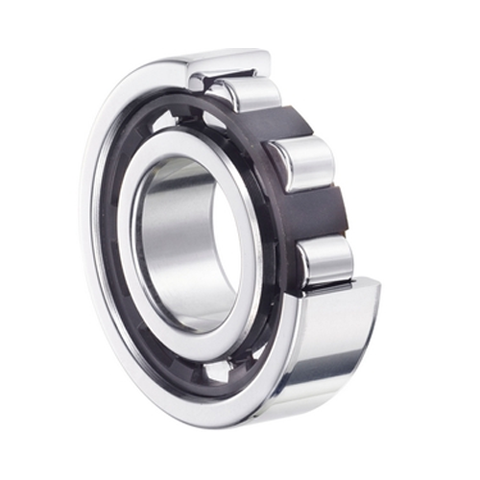
NTN NTN N214C3 Cylindrical Roller Bearing - D=70
NTN N214C3 Cylindrical Roller Bearing (Inside Dia - 70mm, Outside Dia - 125mm) Features Type of Product : Cylindrical Roller Bearing Inside Diameter (d) (mm) : 70 Outside Diameter D (mm) : 125 Width Dia mm : 24 Model No : N214C3 1. Types, design features, and characteristics Cylindrical roller bearings can accommodate heavy radial loads due to the line contact formed between their rolling elements and raceways. These bearings are also suitable for high speed applications since the rollers are guided by either inner or outer ring ribs. Cylindrical roller bearings are separable, allowing them to be easily installed and disassembled even when interference fits are required.Among the various types of cylindrical roller bearings, E type and EA type have a high load capacity while maintaining standard boundary dimensions. HT type has a large axial load capacity, and HL type provides extended fatigue life in poor lubrication conditions. Multiple row bearing arrangements are also available.For extremely heavy load applications, the non-separable full complement SL type bearing offers special advantages. For SL type and four- row cylindrical roller bearings, see section “C. Special application bearings.”Table 1 shows the various types and characteristics of single row cylindrical roller bearings. Table 2 shows the characteristics of non-standard type cylindrical roller bearings. Table 1 Cylindrical roller bearing types and characteristics Type code Design Characteristics NU type N type -NU type outer rings have two ribs. The outer ring, roller, and cage assembly can be separated from the inner ring. N type inner rings have two ribs. The inner ring, roller, and cage assembly can be separated from the outer ring.-Unable to accommodate any axial loading. -This is widely used as the floating side bearing in a fixed-float arrangement. NJ type NF type -NJ type has two ribs on the outer ring, a single rib on the inner ring; NF type has a single rib on the outer ring, and two ribs on the inner ring.-Can receive single direction axial loads. -When there is no distinction between the fixed side and floating side bearing, these types can be used as a pair in close proximity. NUP type NH type (NJ+HJ) -NUP type has a collar ring attached to the ribless side of the inner ring; NH type is NJ type with an L type collar ring attached. All of these collar rings are separable, and therefore it is necessary to fix the inner ring axially. -Can accommodate axial loads in either direction. -Widely used as the shaft’s fixed-side bearing Table 2 Non-standard type cylindrical roller bearing characteristics Designation Characteristics E type and EA type Cylindrical roller bearing -Boundary dimensions are the same as the standard type, but the diameter, length and number of the rollers have been increased, resulting in higher load capacity. -Identified by the addition of “E” to the end of the basic roller number. -Enables compact design due increased load rating. -Rollers’ inscribed circle diameter differs from the standard type rollers and therefore cannot be interchanged. -EA type bearings are ULTAGE series1). Note: In the dimension tables, both E type and EA type are listed. Cylindrical roller bearing for axial loads (HT type) -Can accommodate larger axial loads than the standard type due to improved geometry of the rib roller end surface. -Please consult NTN Engineering concerning necessary considerations, such as load, lubricant, and installation conditions. Double-row cylindrical roller bearing -NN type and NNU type are available. -Widely used for applications requiring thin-walled bearings, such the main shafts of machine tools, rolling machine rollers, and in printing equipment. -Internal radial clearance is adjusted for the spindle of machine tools by pressing the tapered bore of the inner ring on a tapered shaft. Remarks: For precision bearings for machine tools, see precision rolling bearings 2. Standard cage type Table 3 shows the standard cage types for cylindrical roller bearings. The basic load ratings listed in the dimension charts correspond to use of the standard cages listed in Table 3. The basic load ratings listed in the dimension tables are for standard configurations. These ratings can change when a different cage type and number of rolling elements is utilized. Note: 1. Within the same bearing series, cage type is constant regardless of the cylindrical roller bearing type (NJ, NUP, N, NF).2. For high speed and other special applications, machined cages can be manufactured when necessary. Consult NTN Engineering.3. Among EA type bearings that use resin cages as standard, certain varieties use pressed cages. Consult NTN Engineering.4. Although machined cages are the standard for two-row cylindrical roller bearings, resin cages may also be used in some of these bearings for machine tool applications.
$65.94
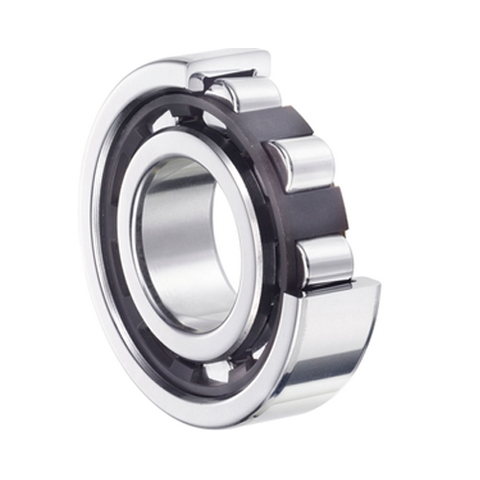
NTN NTN N213 Cylindrical Roller Bearing - D=65
NTN N213 Cylindrical Roller Bearing (Inside Dia - 65mm, Outside Dia - 120mm) Features Type of Product : Cylindrical Roller Bearing Inside Diameter (d) (mm) : 65 Outside Diameter D (mm) : 120 Width Dia mm : 23 Model No : N213 1. Types, design features, and characteristics Cylindrical roller bearings can accommodate heavy radial loads due to the line contact formed between their rolling elements and raceways. These bearings are also suitable for high speed applications since the rollers are guided by either inner or outer ring ribs. Cylindrical roller bearings are separable, allowing them to be easily installed and disassembled even when interference fits are required.Among the various types of cylindrical roller bearings, E type and EA type have a high load capacity while maintaining standard boundary dimensions. HT type has a large axial load capacity, and HL type provides extended fatigue life in poor lubrication conditions. Multiple row bearing arrangements are also available.For extremely heavy load applications, the non-separable full complement SL type bearing offers special advantages. For SL type and four- row cylindrical roller bearings, see section “C. Special application bearings.”Table 1 shows the various types and characteristics of single row cylindrical roller bearings. Table 2 shows the characteristics of non-standard type cylindrical roller bearings. Table 1 Cylindrical roller bearing types and characteristics Type code Design Characteristics NU type N type -NU type outer rings have two ribs. The outer ring, roller, and cage assembly can be separated from the inner ring. N type inner rings have two ribs. The inner ring, roller, and cage assembly can be separated from the outer ring.-Unable to accommodate any axial loading. -This is widely used as the floating side bearing in a fixed-float arrangement. NJ type NF type -NJ type has two ribs on the outer ring, a single rib on the inner ring; NF type has a single rib on the outer ring, and two ribs on the inner ring.-Can receive single direction axial loads. -When there is no distinction between the fixed side and floating side bearing, these types can be used as a pair in close proximity. NUP type NH type (NJ+HJ) -NUP type has a collar ring attached to the ribless side of the inner ring; NH type is NJ type with an L type collar ring attached. All of these collar rings are separable, and therefore it is necessary to fix the inner ring axially. -Can accommodate axial loads in either direction. -Widely used as the shaft’s fixed-side bearing Table 2 Non-standard type cylindrical roller bearing characteristics Designation Characteristics E type and EA type Cylindrical roller bearing -Boundary dimensions are the same as the standard type, but the diameter, length and number of the rollers have been increased, resulting in higher load capacity. -Identified by the addition of “E” to the end of the basic roller number. -Enables compact design due increased load rating. -Rollers’ inscribed circle diameter differs from the standard type rollers and therefore cannot be interchanged. -EA type bearings are ULTAGE series1). Note: In the dimension tables, both E type and EA type are listed. Cylindrical roller bearing for axial loads (HT type) -Can accommodate larger axial loads than the standard type due to improved geometry of the rib roller end surface. -Please consult NTN Engineering concerning necessary considerations, such as load, lubricant, and installation conditions. Double-row cylindrical roller bearing -NN type and NNU type are available. -Widely used for applications requiring thin-walled bearings, such the main shafts of machine tools, rolling machine rollers, and in printing equipment. -Internal radial clearance is adjusted for the spindle of machine tools by pressing the tapered bore of the inner ring on a tapered shaft. Remarks: For precision bearings for machine tools, see precision rolling bearings 2. Standard cage type Table 3 shows the standard cage types for cylindrical roller bearings. The basic load ratings listed in the dimension charts correspond to use of the standard cages listed in Table 3. The basic load ratings listed in the dimension tables are for standard configurations. These ratings can change when a different cage type and number of rolling elements is utilized. Note: 1. Within the same bearing series, cage type is constant regardless of the cylindrical roller bearing type (NJ, NUP, N, NF).2. For high speed and other special applications, machined cages can be manufactured when necessary. Consult NTN Engineering.3. Among EA type bearings that use resin cages as standard, certain varieties use pressed cages. Consult NTN Engineering.4. Although machined cages are the standard for two-row cylindrical roller bearings, resin cages may also be used in some of these bearings for machine tool applications.
$59.48

NTN NTN Double Row Angular Contact Bearing , 5314
Item # d D B r Static Load Rating Dynamic Load Rating 5314 2.7559 in 70.000 mm 5.9055 in 150.000 mm 2.5000 in 63.500 mm 0.0827 in 2.100 mm 28800 lbf 128000 N 128.00 kN 35500 lbf 159000 N 159.00 kN Angular Contact Ball Bearings 1. Design features and characteristics 1.1 Angular contact ball bearing Angular contact ball bearings are non-separable bearings with a defined contact angle in the radial direction relative to the straight line that runs through the point where each ball makes contact with the inner and outer rings (see Fig. 1). Table 1 provides information on contact angles and their designated codes. In addition to radial loads, angular contact ball bearings can accommodate single direction axial loads. Since an axial load is generated from a radial force, these bearings are generally used in pairs. Table 2 shows general angular contact ball bearing characteristics, Table 3 shows information on using duplex (side by side) angular contact ball bearings, and Table 4 shows information on multiple-row angular contact ball bearings. For bearings with a contact angle of 15° and bearing tolerance JIS Class 5 or higher, see special catalog “Precision rolling bearings (CAT. No. 2260/E)”. 1.2 Four-point angular contact ball bearings Four-point angular contact ball bearings have a contact angle of 30° and a split inner ring. As shown in Fig. 2, when the inner and outer rings receive a radial load, the ball contacts the inner and outer rings at four points. This construction enables a single bearing to accommodate axial loads from either direction, and when under a simple axial load or heavy axial load, the bearing relies on two contact points like ordinary bearings. 1.3 Double row angular contact ball bearings The structure of double row angular contact ball bearings is designed by arranging two single row angular contact bearings back-to-back in duplex (DB) to form a single bearing with a contact angle of 25°.These bearings are capable of accommodating radial loads, axial loads in either direction, and have a high capacity for moment loads.As shown in Fig. 4, sealed and shielded type double row angular contact ball bearings are also available. Standard loads vary from those of open type bearings.
$170.95

NTN NTN Double Row Angular Contact Bearing , 5312
Item # d D B r Static Load Rating Dynamic Load Rating 5312 2.3622 in 60.000 mm 5.1181 in 130.000 mm 2.1260 in 54.000 mm 0.0827 in 2.100 mm 22100 lbf 98500 N 98.50 kN 28100 lbf 125000 N 125.00 kN Angular Contact Ball Bearings 1. Design features and characteristics 1.1 Angular contact ball bearing Angular contact ball bearings are non-separable bearings with a defined contact angle in the radial direction relative to the straight line that runs through the point where each ball makes contact with the inner and outer rings (see Fig. 1). Table 1 provides information on contact angles and their designated codes. In addition to radial loads, angular contact ball bearings can accommodate single direction axial loads. Since an axial load is generated from a radial force, these bearings are generally used in pairs. Table 2 shows general angular contact ball bearing characteristics, Table 3 shows information on using duplex (side by side) angular contact ball bearings, and Table 4 shows information on multiple-row angular contact ball bearings. For bearings with a contact angle of 15° and bearing tolerance JIS Class 5 or higher, see special catalog “Precision rolling bearings (CAT. No. 2260/E)”. 1.2 Four-point angular contact ball bearings Four-point angular contact ball bearings have a contact angle of 30° and a split inner ring. As shown in Fig. 2, when the inner and outer rings receive a radial load, the ball contacts the inner and outer rings at four points. This construction enables a single bearing to accommodate axial loads from either direction, and when under a simple axial load or heavy axial load, the bearing relies on two contact points like ordinary bearings. 1.3 Double row angular contact ball bearings The structure of double row angular contact ball bearings is designed by arranging two single row angular contact bearings back-to-back in duplex (DB) to form a single bearing with a contact angle of 25°.These bearings are capable of accommodating radial loads, axial loads in either direction, and have a high capacity for moment loads.As shown in Fig. 4, sealed and shielded type double row angular contact ball bearings are also available. Standard loads vary from those of open type bearings.
$89.47

NTN NTN Double Row Angular Contact Bearing , 5311
Item # d D B r Static Load Rating Dynamic Load Rating 5311 2.1654 in 55.000 mm 4.7244 in 120.000 mm 1.9370 in 49.200 mm 0.0787 in 2.000 mm 16400 lbf 73000 N 73.00 kN 21400 lbf 95000 N 95.00 kN Angular Contact Ball Bearings 1. Design features and characteristics 1.1 Angular contact ball bearing Angular contact ball bearings are non-separable bearings with a defined contact angle in the radial direction relative to the straight line that runs through the point where each ball makes contact with the inner and outer rings (see Fig. 1). Table 1 provides information on contact angles and their designated codes. In addition to radial loads, angular contact ball bearings can accommodate single direction axial loads. Since an axial load is generated from a radial force, these bearings are generally used in pairs. Table 2 shows general angular contact ball bearing characteristics, Table 3 shows information on using duplex (side by side) angular contact ball bearings, and Table 4 shows information on multiple-row angular contact ball bearings. For bearings with a contact angle of 15° and bearing tolerance JIS Class 5 or higher, see special catalog “Precision rolling bearings (CAT. No. 2260/E)”. 1.2 Four-point angular contact ball bearings Four-point angular contact ball bearings have a contact angle of 30° and a split inner ring. As shown in Fig. 2, when the inner and outer rings receive a radial load, the ball contacts the inner and outer rings at four points. This construction enables a single bearing to accommodate axial loads from either direction, and when under a simple axial load or heavy axial load, the bearing relies on two contact points like ordinary bearings. 1.3 Double row angular contact ball bearings The structure of double row angular contact ball bearings is designed by arranging two single row angular contact bearings back-to-back in duplex (DB) to form a single bearing with a contact angle of 25°.These bearings are capable of accommodating radial loads, axial loads in either direction, and have a high capacity for moment loads.As shown in Fig. 4, sealed and shielded type double row angular contact ball bearings are also available. Standard loads vary from those of open type bearings.
$69.68

NTN NTN Double Row Angular Contact Bearing , 5310
Item # d D B r Static Load Rating Dynamic Load Rating 5310 1.9685 in 50.000 mm 4.3307 in 110.000 mm 1.7480 in 44.400 mm 0.0787 in 2.000 mm 13800 lbf 61500 N 61.50 kN 18300 lbf 81500 N 81.50 kN Angular Contact Ball Bearings 1. Design features and characteristics 1.1 Angular contact ball bearing Angular contact ball bearings are non-separable bearings with a defined contact angle in the radial direction relative to the straight line that runs through the point where each ball makes contact with the inner and outer rings (see Fig. 1). Table 1 provides information on contact angles and their designated codes. In addition to radial loads, angular contact ball bearings can accommodate single direction axial loads. Since an axial load is generated from a radial force, these bearings are generally used in pairs. Table 2 shows general angular contact ball bearing characteristics, Table 3 shows information on using duplex (side by side) angular contact ball bearings, and Table 4 shows information on multiple-row angular contact ball bearings. For bearings with a contact angle of 15° and bearing tolerance JIS Class 5 or higher, see special catalog “Precision rolling bearings (CAT. No. 2260/E)”. 1.2 Four-point angular contact ball bearings Four-point angular contact ball bearings have a contact angle of 30° and a split inner ring. As shown in Fig. 2, when the inner and outer rings receive a radial load, the ball contacts the inner and outer rings at four points. This construction enables a single bearing to accommodate axial loads from either direction, and when under a simple axial load or heavy axial load, the bearing relies on two contact points like ordinary bearings. 1.3 Double row angular contact ball bearings The structure of double row angular contact ball bearings is designed by arranging two single row angular contact bearings back-to-back in duplex (DB) to form a single bearing with a contact angle of 25°.These bearings are capable of accommodating radial loads, axial loads in either direction, and have a high capacity for moment loads.As shown in Fig. 4, sealed and shielded type double row angular contact ball bearings are also available. Standard loads vary from those of open type bearings.
$54.79

NTN NTN Double Row Angular Contact Bearing , 5306
Item # d D B r Static Load Rating Dynamic Load Rating 5306 1.1811 in 30.000 mm 2.8346 in 72.000 mm 1.1890 in 30.200 mm 0.0433 in 1.100 mm 6300 lbf 28100 N 28.10 kN 9100 lbf 40500 N 40.50 kN Angular Contact Ball Bearings 1. Design features and characteristics 1.1 Angular contact ball bearing Angular contact ball bearings are non-separable bearings with a defined contact angle in the radial direction relative to the straight line that runs through the point where each ball makes contact with the inner and outer rings (see Fig. 1). Table 1 provides information on contact angles and their designated codes. In addition to radial loads, angular contact ball bearings can accommodate single direction axial loads. Since an axial load is generated from a radial force, these bearings are generally used in pairs. Table 2 shows general angular contact ball bearing characteristics, Table 3 shows information on using duplex (side by side) angular contact ball bearings, and Table 4 shows information on multiple-row angular contact ball bearings. For bearings with a contact angle of 15° and bearing tolerance JIS Class 5 or higher, see special catalog “Precision rolling bearings (CAT. No. 2260/E)”. 1.2 Four-point angular contact ball bearings Four-point angular contact ball bearings have a contact angle of 30° and a split inner ring. As shown in Fig. 2, when the inner and outer rings receive a radial load, the ball contacts the inner and outer rings at four points. This construction enables a single bearing to accommodate axial loads from either direction, and when under a simple axial load or heavy axial load, the bearing relies on two contact points like ordinary bearings. 1.3 Double row angular contact ball bearings The structure of double row angular contact ball bearings is designed by arranging two single row angular contact bearings back-to-back in duplex (DB) to form a single bearing with a contact angle of 25°.These bearings are capable of accommodating radial loads, axial loads in either direction, and have a high capacity for moment loads.As shown in Fig. 4, sealed and shielded type double row angular contact ball bearings are also available. Standard loads vary from those of open type bearings.
$25.76

NTN NTN Double Row Angular Contact Bearing , 5305
Item # d D B r Static Load Rating Dynamic Load Rating 5305 0.9843 in 25.000 mm 2.4409 in 62.000 mm 1.0000 in 25.400 mm 0.0433 in 1.100 mm 4650 lbf 20700 N 20.70 kN 7300 lbf 32500 N 32.50 kN Angular Contact Ball Bearings 1. Design features and characteristics 1.1 Angular contact ball bearing Angular contact ball bearings are non-separable bearings with a defined contact angle in the radial direction relative to the straight line that runs through the point where each ball makes contact with the inner and outer rings (see Fig. 1). Table 1 provides information on contact angles and their designated codes. In addition to radial loads, angular contact ball bearings can accommodate single direction axial loads. Since an axial load is generated from a radial force, these bearings are generally used in pairs. Table 2 shows general angular contact ball bearing characteristics, Table 3 shows information on using duplex (side by side) angular contact ball bearings, and Table 4 shows information on multiple-row angular contact ball bearings. For bearings with a contact angle of 15° and bearing tolerance JIS Class 5 or higher, see special catalog “Precision rolling bearings (CAT. No. 2260/E)”. 1.2 Four-point angular contact ball bearings Four-point angular contact ball bearings have a contact angle of 30° and a split inner ring. As shown in Fig. 2, when the inner and outer rings receive a radial load, the ball contacts the inner and outer rings at four points. This construction enables a single bearing to accommodate axial loads from either direction, and when under a simple axial load or heavy axial load, the bearing relies on two contact points like ordinary bearings. 1.3 Double row angular contact ball bearings The structure of double row angular contact ball bearings is designed by arranging two single row angular contact bearings back-to-back in duplex (DB) to form a single bearing with a contact angle of 25°.These bearings are capable of accommodating radial loads, axial loads in either direction, and have a high capacity for moment loads.As shown in Fig. 4, sealed and shielded type double row angular contact ball bearings are also available. Standard loads vary from those of open type bearings.
$19.83

NTN NTN Double Row Angular Contact Bearing , 5304
Item # d D B r Static Load Rating Dynamic Load Rating 5304 0.7874 in 20.000 mm 2.0472 in 52.000 mm 0.8740 in 22.200 mm 0.0433 in 1.100 mm 3350 lbf 15000 N 15.00 kN 5550 lbf 24600 N 24.60 kN Angular Contact Ball Bearings 1. Design features and characteristics 1.1 Angular contact ball bearing Angular contact ball bearings are non-separable bearings with a defined contact angle in the radial direction relative to the straight line that runs through the point where each ball makes contact with the inner and outer rings (see Fig. 1). Table 1 provides information on contact angles and their designated codes. In addition to radial loads, angular contact ball bearings can accommodate single direction axial loads. Since an axial load is generated from a radial force, these bearings are generally used in pairs. Table 2 shows general angular contact ball bearing characteristics, Table 3 shows information on using duplex (side by side) angular contact ball bearings, and Table 4 shows information on multiple-row angular contact ball bearings. For bearings with a contact angle of 15° and bearing tolerance JIS Class 5 or higher, see special catalog “Precision rolling bearings (CAT. No. 2260/E)”. 1.2 Four-point angular contact ball bearings Four-point angular contact ball bearings have a contact angle of 30° and a split inner ring. As shown in Fig. 2, when the inner and outer rings receive a radial load, the ball contacts the inner and outer rings at four points. This construction enables a single bearing to accommodate axial loads from either direction, and when under a simple axial load or heavy axial load, the bearing relies on two contact points like ordinary bearings. 1.3 Double row angular contact ball bearings The structure of double row angular contact ball bearings is designed by arranging two single row angular contact bearings back-to-back in duplex (DB) to form a single bearing with a contact angle of 25°.These bearings are capable of accommodating radial loads, axial loads in either direction, and have a high capacity for moment loads.As shown in Fig. 4, sealed and shielded type double row angular contact ball bearings are also available. Standard loads vary from those of open type bearings.
$18.51

NTN NTN Double Row Angular Contact Bearing , 5303
Item # d D B r Static Load Rating Dynamic Load Rating 5303 0.6693 in 17.000 mm 1.8504 in 47.000 mm 0.8740 in 22.200 mm 0.0394 in 1.000 mm 2830 lbf 12600 N 12.60 kN 4700 lbf 21000 N 21.00 kN Angular Contact Ball Bearings 1. Design features and characteristics 1.1 Angular contact ball bearing Angular contact ball bearings are non-separable bearings with a defined contact angle in the radial direction relative to the straight line that runs through the point where each ball makes contact with the inner and outer rings (see Fig. 1). Table 1 provides information on contact angles and their designated codes. In addition to radial loads, angular contact ball bearings can accommodate single direction axial loads. Since an axial load is generated from a radial force, these bearings are generally used in pairs. Table 2 shows general angular contact ball bearing characteristics, Table 3 shows information on using duplex (side by side) angular contact ball bearings, and Table 4 shows information on multiple-row angular contact ball bearings. For bearings with a contact angle of 15° and bearing tolerance JIS Class 5 or higher, see special catalog “Precision rolling bearings (CAT. No. 2260/E)”. 1.2 Four-point angular contact ball bearings Four-point angular contact ball bearings have a contact angle of 30° and a split inner ring. As shown in Fig. 2, when the inner and outer rings receive a radial load, the ball contacts the inner and outer rings at four points. This construction enables a single bearing to accommodate axial loads from either direction, and when under a simple axial load or heavy axial load, the bearing relies on two contact points like ordinary bearings. 1.3 Double row angular contact ball bearings The structure of double row angular contact ball bearings is designed by arranging two single row angular contact bearings back-to-back in duplex (DB) to form a single bearing with a contact angle of 25°.These bearings are capable of accommodating radial loads, axial loads in either direction, and have a high capacity for moment loads.As shown in Fig. 4, sealed and shielded type double row angular contact ball bearings are also available. Standard loads vary from those of open type bearings.
$17.19

NTN NTN Double Row Angular Contact Bearing , 5302
Item # d D B r Static Load Rating Dynamic Load Rating 5302 0.5906 in 15.000 mm 1.6535 in 42.000 mm 0.7480 in 19.000 mm 0.0394 in 1.000 mm 2290 lbf 10200 N 10.20 kN 3950 lbf 17600 N 17.60 kN Angular Contact Ball Bearings 1. Design features and characteristics 1.1 Angular contact ball bearing Angular contact ball bearings are non-separable bearings with a defined contact angle in the radial direction relative to the straight line that runs through the point where each ball makes contact with the inner and outer rings (see Fig. 1). Table 1 provides information on contact angles and their designated codes. In addition to radial loads, angular contact ball bearings can accommodate single direction axial loads. Since an axial load is generated from a radial force, these bearings are generally used in pairs. Table 2 shows general angular contact ball bearing characteristics, Table 3 shows information on using duplex (side by side) angular contact ball bearings, and Table 4 shows information on multiple-row angular contact ball bearings. For bearings with a contact angle of 15° and bearing tolerance JIS Class 5 or higher, see special catalog “Precision rolling bearings (CAT. No. 2260/E)”. 1.2 Four-point angular contact ball bearings Four-point angular contact ball bearings have a contact angle of 30° and a split inner ring. As shown in Fig. 2, when the inner and outer rings receive a radial load, the ball contacts the inner and outer rings at four points. This construction enables a single bearing to accommodate axial loads from either direction, and when under a simple axial load or heavy axial load, the bearing relies on two contact points like ordinary bearings. 1.3 Double row angular contact ball bearings The structure of double row angular contact ball bearings is designed by arranging two single row angular contact bearings back-to-back in duplex (DB) to form a single bearing with a contact angle of 25°.These bearings are capable of accommodating radial loads, axial loads in either direction, and have a high capacity for moment loads.As shown in Fig. 4, sealed and shielded type double row angular contact ball bearings are also available. Standard loads vary from those of open type bearings.
$13.74

NTN NTN Double Row Angular Contact Bearing , 5216
Item # d D B r Static Load Rating Dynamic Load Rating 5216 3.1496 in 80.000 mm 5.5118 in 140.000 mm 1.7480 in 44.400 mm 0.0787 in 2.000 mm 20900 lbf 93000 N 93.00 kN 22300 lbf 99000 N 99.00 kN Angular Contact Ball Bearings 1. Design features and characteristics 1.1 Angular contact ball bearing Angular contact ball bearings are non-separable bearings with a defined contact angle in the radial direction relative to the straight line that runs through the point where each ball makes contact with the inner and outer rings (see Fig. 1). Table 1 provides information on contact angles and their designated codes. In addition to radial loads, angular contact ball bearings can accommodate single direction axial loads. Since an axial load is generated from a radial force, these bearings are generally used in pairs. Table 2 shows general angular contact ball bearing characteristics, Table 3 shows information on using duplex (side by side) angular contact ball bearings, and Table 4 shows information on multiple-row angular contact ball bearings. For bearings with a contact angle of 15° and bearing tolerance JIS Class 5 or higher, see special catalog “Precision rolling bearings (CAT. No. 2260/E)”. 1.2 Four-point angular contact ball bearings Four-point angular contact ball bearings have a contact angle of 30° and a split inner ring. As shown in Fig. 2, when the inner and outer rings receive a radial load, the ball contacts the inner and outer rings at four points. This construction enables a single bearing to accommodate axial loads from either direction, and when under a simple axial load or heavy axial load, the bearing relies on two contact points like ordinary bearings. 1.3 Double row angular contact ball bearings The structure of double row angular contact ball bearings is designed by arranging two single row angular contact bearings back-to-back in duplex (DB) to form a single bearing with a contact angle of 25°.These bearings are capable of accommodating radial loads, axial loads in either direction, and have a high capacity for moment loads.As shown in Fig. 4, sealed and shielded type double row angular contact ball bearings are also available. Standard loads vary from those of open type bearings.
$122.41

NTN NTN Double Row Angular Contact Bearing , 5215
Item # d D B r Static Load Rating Dynamic Load Rating 5215 2.9528 in 75.000 mm 5.1181 in 130.000 mm 1.6260 in 41.300 mm 0.0591 in 1.500 mm 18700 lbf 83000 N 83.00 kN 21000 lbf 93500 N 93.50 kN Angular Contact Ball Bearings 1. Design features and characteristics 1.1 Angular contact ball bearing Angular contact ball bearings are non-separable bearings with a defined contact angle in the radial direction relative to the straight line that runs through the point where each ball makes contact with the inner and outer rings (see Fig. 1). Table 1 provides information on contact angles and their designated codes. In addition to radial loads, angular contact ball bearings can accommodate single direction axial loads. Since an axial load is generated from a radial force, these bearings are generally used in pairs. Table 2 shows general angular contact ball bearing characteristics, Table 3 shows information on using duplex (side by side) angular contact ball bearings, and Table 4 shows information on multiple-row angular contact ball bearings. For bearings with a contact angle of 15° and bearing tolerance JIS Class 5 or higher, see special catalog “Precision rolling bearings (CAT. No. 2260/E)”. 1.2 Four-point angular contact ball bearings Four-point angular contact ball bearings have a contact angle of 30° and a split inner ring. As shown in Fig. 2, when the inner and outer rings receive a radial load, the ball contacts the inner and outer rings at four points. This construction enables a single bearing to accommodate axial loads from either direction, and when under a simple axial load or heavy axial load, the bearing relies on two contact points like ordinary bearings. 1.3 Double row angular contact ball bearings The structure of double row angular contact ball bearings is designed by arranging two single row angular contact bearings back-to-back in duplex (DB) to form a single bearing with a contact angle of 25°.These bearings are capable of accommodating radial loads, axial loads in either direction, and have a high capacity for moment loads.As shown in Fig. 4, sealed and shielded type double row angular contact ball bearings are also available. Standard loads vary from those of open type bearings.
$88.28

NTN NTN Double Row Angular Contact Bearing , 5214
Item # d D B r Static Load Rating Dynamic Load Rating 5214 2.7559 in 70.000 mm 4.9213 in 125.000 mm 1.5630 in 39.700 mm 0.0591 in 1.500 mm 18400 lbf 82000 N 82.00 kN 21100 lbf 94000 N 94.00 kN Angular Contact Ball Bearings 1. Design features and characteristics 1.1 Angular contact ball bearing Angular contact ball bearings are non-separable bearings with a defined contact angle in the radial direction relative to the straight line that runs through the point where each ball makes contact with the inner and outer rings (see Fig. 1). Table 1 provides information on contact angles and their designated codes. In addition to radial loads, angular contact ball bearings can accommodate single direction axial loads. Since an axial load is generated from a radial force, these bearings are generally used in pairs. Table 2 shows general angular contact ball bearing characteristics, Table 3 shows information on using duplex (side by side) angular contact ball bearings, and Table 4 shows information on multiple-row angular contact ball bearings. For bearings with a contact angle of 15° and bearing tolerance JIS Class 5 or higher, see special catalog “Precision rolling bearings (CAT. No. 2260/E)”. 1.2 Four-point angular contact ball bearings Four-point angular contact ball bearings have a contact angle of 30° and a split inner ring. As shown in Fig. 2, when the inner and outer rings receive a radial load, the ball contacts the inner and outer rings at four points. This construction enables a single bearing to accommodate axial loads from either direction, and when under a simple axial load or heavy axial load, the bearing relies on two contact points like ordinary bearings. 1.3 Double row angular contact ball bearings The structure of double row angular contact ball bearings is designed by arranging two single row angular contact bearings back-to-back in duplex (DB) to form a single bearing with a contact angle of 25°.These bearings are capable of accommodating radial loads, axial loads in either direction, and have a high capacity for moment loads.As shown in Fig. 4, sealed and shielded type double row angular contact ball bearings are also available. Standard loads vary from those of open type bearings.
$69.76

NTN NTN Double Row Angular Contact Bearing , 5204
Item # d D B r Static Load Rating Dynamic Load Rating 5204 0.7874 in 20.000 mm 1.8504 in 47.000 mm 0.8110 in 20.600 mm 0.0394 in 1.000 mm 2720 lbf 12100 N 12.10 kN 4250 lbf 19000 N 19.00 kN Angular Contact Ball Bearings 1. Design features and characteristics 1.1 Angular contact ball bearing Angular contact ball bearings are non-separable bearings with a defined contact angle in the radial direction relative to the straight line that runs through the point where each ball makes contact with the inner and outer rings (see Fig. 1). Table 1 provides information on contact angles and their designated codes. In addition to radial loads, angular contact ball bearings can accommodate single direction axial loads. Since an axial load is generated from a radial force, these bearings are generally used in pairs. Table 2 shows general angular contact ball bearing characteristics, Table 3 shows information on using duplex (side by side) angular contact ball bearings, and Table 4 shows information on multiple-row angular contact ball bearings. For bearings with a contact angle of 15° and bearing tolerance JIS Class 5 or higher, see special catalog “Precision rolling bearings (CAT. No. 2260/E)”. 1.2 Four-point angular contact ball bearings Four-point angular contact ball bearings have a contact angle of 30° and a split inner ring. As shown in Fig. 2, when the inner and outer rings receive a radial load, the ball contacts the inner and outer rings at four points. This construction enables a single bearing to accommodate axial loads from either direction, and when under a simple axial load or heavy axial load, the bearing relies on two contact points like ordinary bearings. 1.3 Double row angular contact ball bearings The structure of double row angular contact ball bearings is designed by arranging two single row angular contact bearings back-to-back in duplex (DB) to form a single bearing with a contact angle of 25°.These bearings are capable of accommodating radial loads, axial loads in either direction, and have a high capacity for moment loads.As shown in Fig. 4, sealed and shielded type double row angular contact ball bearings are also available. Standard loads vary from those of open type bearings.
$14.03

NTN NTN Double Row Angular Contact Bearing , 5201
Item # d D B r Static Load Rating Dynamic Load Rating 5201 0.4724 in 12.000 mm 1.2598 in 32.000 mm 0.6260 in 15.900 mm 0.0236 in 0.600 mm 1140 lbf 5050 N 5.05 kN 2060 lbf 9150 N 9.15 kN Angular Contact Ball Bearings 1. Design features and characteristics 1.1 Angular contact ball bearing Angular contact ball bearings are non-separable bearings with a defined contact angle in the radial direction relative to the straight line that runs through the point where each ball makes contact with the inner and outer rings (see Fig. 1). Table 1 provides information on contact angles and their designated codes. In addition to radial loads, angular contact ball bearings can accommodate single direction axial loads. Since an axial load is generated from a radial force, these bearings are generally used in pairs. Table 2 shows general angular contact ball bearing characteristics, Table 3 shows information on using duplex (side by side) angular contact ball bearings, and Table 4 shows information on multiple-row angular contact ball bearings. For bearings with a contact angle of 15° and bearing tolerance JIS Class 5 or higher, see special catalog “Precision rolling bearings (CAT. No. 2260/E)”. 1.2 Four-point angular contact ball bearings Four-point angular contact ball bearings have a contact angle of 30° and a split inner ring. As shown in Fig. 2, when the inner and outer rings receive a radial load, the ball contacts the inner and outer rings at four points. This construction enables a single bearing to accommodate axial loads from either direction, and when under a simple axial load or heavy axial load, the bearing relies on two contact points like ordinary bearings. 1.3 Double row angular contact ball bearings The structure of double row angular contact ball bearings is designed by arranging two single row angular contact bearings back-to-back in duplex (DB) to form a single bearing with a contact angle of 25°.These bearings are capable of accommodating radial loads, axial loads in either direction, and have a high capacity for moment loads.As shown in Fig. 4, sealed and shielded type double row angular contact ball bearings are also available. Standard loads vary from those of open type bearings.
$11.83

NTN NTN Double Row Angular Contact Bearing , 5200
Item # d D B r Static Load Rating Dynamic Load Rating 5200 0.3937 in 10.000 mm 1.1811 in 30.000 mm 0.5630 in 14.300 mm 0.0236 in 0.600 mm 875 lbf 3900 N 3.90 kN 1610 lbf 7150 N 7.15 kN Angular Contact Ball Bearings 1. Design features and characteristics 1.1 Angular contact ball bearing Angular contact ball bearings are non-separable bearings with a defined contact angle in the radial direction relative to the straight line that runs through the point where each ball makes contact with the inner and outer rings (see Fig. 1). Table 1 provides information on contact angles and their designated codes. In addition to radial loads, angular contact ball bearings can accommodate single direction axial loads. Since an axial load is generated from a radial force, these bearings are generally used in pairs. Table 2 shows general angular contact ball bearing characteristics, Table 3 shows information on using duplex (side by side) angular contact ball bearings, and Table 4 shows information on multiple-row angular contact ball bearings. For bearings with a contact angle of 15° and bearing tolerance JIS Class 5 or higher, see special catalog “Precision rolling bearings (CAT. No. 2260/E)”. 1.2 Four-point angular contact ball bearings Four-point angular contact ball bearings have a contact angle of 30° and a split inner ring. As shown in Fig. 2, when the inner and outer rings receive a radial load, the ball contacts the inner and outer rings at four points. This construction enables a single bearing to accommodate axial loads from either direction, and when under a simple axial load or heavy axial load, the bearing relies on two contact points like ordinary bearings. 1.3 Double row angular contact ball bearings The structure of double row angular contact ball bearings is designed by arranging two single row angular contact bearings back-to-back in duplex (DB) to form a single bearing with a contact angle of 25°.These bearings are capable of accommodating radial loads, axial loads in either direction, and have a high capacity for moment loads.As shown in Fig. 4, sealed and shielded type double row angular contact ball bearings are also available. Standard loads vary from those of open type bearings.
$11.14

NTN NTN 7214BDB Angular Contact Bearing - D=70
NTN 7214BDB Angular Contact Bearing - D=70 The values in the “Width (mm)” section of product specification are per-row (single-row) width even when a double-row combination product is selected (B Dimension in catalog).Please be aware that the overall width for double-row products is twice as wide (2B) as those indicated dimensions. SPECIFICATIONS Type Angular Contact Ball Bearing (Double Row) Inner/Outer Ring Material [Steel] Steel Bearing Style Double Shielded Outer Ring Shape Flat Precision Grade 0 I.D.(Ø) 70 O.D.(Ø) 125 Width(mm) 24 Basic Dynamic Load Rating(N) 69000 Max. Allowed rpm(rpm) - Specifications, Environment Standard / For high Speed Load Direction Radial Outer Ring With Outer Ring Size Standards Metric System Rolling Element Material [Steel] Steel Combination of Angular Contact Ball Bearings - Retainer Type Resin Forming Basic Load Rating, Static Rating(N) - Clearance sign No Preload No Contact angle(Degree) 40 Holder Symbol No Symbol of Bearing Ring Shape No Seal, Shield Symbols No Precision Grade Symbol No Symbol of contact angle B Combination symbol DB Preload Mark No Special Configurations Code No Bearing type symbol No Type symbol No Material Symbol No Spacer, Sleeve symbol No RoHS 10 Angular Contact Ball Bearings 1. Design features and characteristics 1.1 Angular contact ball bearing Angular contact ball bearings are non-separable bearings with a defined contact angle in the radial direction relative to the straight line that runs through the point where each ball makes contact with the inner and outer rings (see Fig. 1). Table 1 provides information on contact angles and their designated codes. In addition to radial loads, angular contact ball bearings can accommodate single direction axial loads. Since an axial load is generated from a radial force, these bearings are generally used in pairs. Table 2 shows general angular contact ball bearing characteristics, Table 3 shows information on using duplex (side by side) angular contact ball bearings, and Table 4 shows information on multiple-row angular contact ball bearings. For bearings with a contact angle of 15° and bearing tolerance JIS Class 5 or higher, see special catalog “Precision rolling bearings (CAT. No. 2260/E)”. 1.2 Four-point angular contact ball bearings Four-point angular contact ball bearings have a contact angle of 30° and a split inner ring. As shown in Fig. 2, when the inner and outer rings receive a radial load, the ball contacts the inner and outer rings at four points. This construction enables a single bearing to accommodate axial loads from either direction, and when under a simple axial load or heavy axial load, the bearing relies on two contact points like ordinary bearings. 1.3 Double row angular contact ball bearings The structure of double row angular contact ball bearings is designed by arranging two single row angular contact bearings back-to-back in duplex (DB) to form a single bearing with a contact angle of 25°.These bearings are capable of accommodating radial loads, axial loads in either direction, and have a high capacity for moment loads.As shown in Fig. 4, sealed and shielded type double row angular contact ball bearings are also available. Standard loads vary from those of open type bearings.
$53.81

NTN NTN 7212CP5 High Precision Angular Contact Bearing - D=60
NTN 7212CP5 High Precision Angular Contact Bearing - D=60 7212C P5 High Precision Angular Ball Bearing with 15 degrees contact angle. Bearing is ABEC 5 (P5) quality .7212C P5 inner diameter is 60mm, outer diameter is 110mm, width is 22mm. SPECIFICATIONS Item: 7212C P5 Ball Bearing Type: High precision Angular Ball Bearing Cage: PA66+ 30% NTE264B Quality: ABEC-5 (P5 quality) Dimensions: 60mm x 110mm x 22mm/Metric ID (inner diameter)/Bore: 60mm OD (outer diameter): 110mm Width/Height/thickness: 22mm Size: 60 x 110 x 22 mm Quantity: One Bearing Dynamic load rating Cr: 64,500 N Static load rating Cor: 49,500 N Limiting Speed: Grease Lubrication: 9,400 RPM Oil Lubrication: 13,000 RPM Dimensions d D B r r1 a 60mm 110mm 22mm 1.5mm 1mm -1.2mm Angular Contact Ball Bearings 1. Design features and characteristics 1.1 Angular contact ball bearing Angular contact ball bearings are non-separable bearings with a defined contact angle in the radial direction relative to the straight line that runs through the point where each ball makes contact with the inner and outer rings (see Fig. 1). Table 1 provides information on contact angles and their designated codes. In addition to radial loads, angular contact ball bearings can accommodate single direction axial loads. Since an axial load is generated from a radial force, these bearings are generally used in pairs. Table 2 shows general angular contact ball bearing characteristics, Table 3 shows information on using duplex (side by side) angular contact ball bearings, and Table 4 shows information on multiple-row angular contact ball bearings. For bearings with a contact angle of 15° and bearing tolerance JIS Class 5 or higher, see special catalog “Precision rolling bearings (CAT. No. 2260/E)”. 1.2 Four-point angular contact ball bearings Four-point angular contact ball bearings have a contact angle of 30° and a split inner ring. As shown in Fig. 2, when the inner and outer rings receive a radial load, the ball contacts the inner and outer rings at four points. This construction enables a single bearing to accommodate axial loads from either direction, and when under a simple axial load or heavy axial load, the bearing relies on two contact points like ordinary bearings. 1.3 Double row angular contact ball bearings The structure of double row angular contact ball bearings is designed by arranging two single row angular contact bearings back-to-back in duplex (DB) to form a single bearing with a contact angle of 25°.These bearings are capable of accommodating radial loads, axial loads in either direction, and have a high capacity for moment loads.As shown in Fig. 4, sealed and shielded type double row angular contact ball bearings are also available. Standard loads vary from those of open type bearings.
$85.83

NTN NTN 7209CP5 High Precision Angular Contact Bearing - D=45
NTN 7209CP5 High Precision Angular Contact Bearing - D=45 7209C P4 High Precision Angular Ball Bearing with 15 degrees contact angle.bearing is ABEC 5 (P5) quality. SPECIFICATIONS Item: 7209C P5 Ball Bearing Type: High Precision Angular Ball Bearing Cage: PA66 + 30% NTE264B Quality: ABEC-5 (P5 quality) Dimensions: 45mm x 85mm x 19mm/Metric ID (inner diameter)/Bore: 45mm OD (outer diameter): 85mm Width/Height/thickness: 19mm Size: 45 x 85 x 19 mm Quantity: One Bearing Dynamic load rating Cr: 41,000 N Static load rating Cor: 29,000 N Limiting Speed: Grease Lubrication: 12,000 RPM Oil Lubrication: 17,000 RPM Dimensions d D B r r1 a 45mm 85mm 19mm 1.1mm 0.6mm -2mm Angular Contact Ball Bearings 1. Design features and characteristics 1.1 Angular contact ball bearing Angular contact ball bearings are non-separable bearings with a defined contact angle in the radial direction relative to the straight line that runs through the point where each ball makes contact with the inner and outer rings (see Fig. 1). Table 1 provides information on contact angles and their designated codes. In addition to radial loads, angular contact ball bearings can accommodate single direction axial loads. Since an axial load is generated from a radial force, these bearings are generally used in pairs. Table 2 shows general angular contact ball bearing characteristics, Table 3 shows information on using duplex (side by side) angular contact ball bearings, and Table 4 shows information on multiple-row angular contact ball bearings. For bearings with a contact angle of 15° and bearing tolerance JIS Class 5 or higher, see special catalog “Precision rolling bearings (CAT. No. 2260/E)”. 1.2 Four-point angular contact ball bearings Four-point angular contact ball bearings have a contact angle of 30° and a split inner ring. As shown in Fig. 2, when the inner and outer rings receive a radial load, the ball contacts the inner and outer rings at four points. This construction enables a single bearing to accommodate axial loads from either direction, and when under a simple axial load or heavy axial load, the bearing relies on two contact points like ordinary bearings. 1.3 Double row angular contact ball bearings The structure of double row angular contact ball bearings is designed by arranging two single row angular contact bearings back-to-back in duplex (DB) to form a single bearing with a contact angle of 25°.These bearings are capable of accommodating radial loads, axial loads in either direction, and have a high capacity for moment loads.As shown in Fig. 4, sealed and shielded type double row angular contact ball bearings are also available. Standard loads vary from those of open type bearings.
$54.72

NTN NTN 7201CP5 Angular Contact Bearing - D=12
NTN 7201CP5 Angular Contact Bearing - D=12 7201C P5 high precision Angular Ball Bearing with 15 degrees contact angle,ABEC 5 (P5) quality. Inner diameter is 12mm, outer diameter is 32mm and width is 10mm. SPECIFICATIONS Item: 7201C P5 Angular Ball Bearing Type: High Precision Angular Ball Bearing Cage: PA66+ 30% NTE264B Cage Quality: ABEC-5 (P5 quality) Dimensions: 12mm x 32mm x 10mm/Metric ID (inner diameter)/Bore: 12mm OD (outer diameter): 32mm Width/Height/thickness: 10mm Size: 12 x 32 x 10 mm Quantity: One Bearing Dynamic load rating Cr: 7,950 N Static load rating Cor: 3,900 N Limiting Speed: Grease Lubrication: 36,000 RPM Oil Lubrication: 50,000 RPM Angular Contact Ball Bearings 1. Design features and characteristics 1.1 Angular contact ball bearing Angular contact ball bearings are non-separable bearings with a defined contact angle in the radial direction relative to the straight line that runs through the point where each ball makes contact with the inner and outer rings (see Fig. 1). Table 1 provides information on contact angles and their designated codes. In addition to radial loads, angular contact ball bearings can accommodate single direction axial loads. Since an axial load is generated from a radial force, these bearings are generally used in pairs. Table 2 shows general angular contact ball bearing characteristics, Table 3 shows information on using duplex (side by side) angular contact ball bearings, and Table 4 shows information on multiple-row angular contact ball bearings. For bearings with a contact angle of 15° and bearing tolerance JIS Class 5 or higher, see special catalog “Precision rolling bearings (CAT. No. 2260/E)”. 1.2 Four-point angular contact ball bearings Four-point angular contact ball bearings have a contact angle of 30° and a split inner ring. As shown in Fig. 2, when the inner and outer rings receive a radial load, the ball contacts the inner and outer rings at four points. This construction enables a single bearing to accommodate axial loads from either direction, and when under a simple axial load or heavy axial load, the bearing relies on two contact points like ordinary bearings. 1.3 Double row angular contact ball bearings The structure of double row angular contact ball bearings is designed by arranging two single row angular contact bearings back-to-back in duplex (DB) to form a single bearing with a contact angle of 25°.These bearings are capable of accommodating radial loads, axial loads in either direction, and have a high capacity for moment loads.As shown in Fig. 4, sealed and shielded type double row angular contact ball bearings are also available. Standard loads vary from those of open type bearings.
$23.57

NTN NTN 7000CP5 Angular Contact Bearing - D=10
NTN 7000CP5 Angular Contact Bearing - D=10 Angular contact ball bearings are non-separable bearings in which the straight line connecting the contact points between the balls and the inner and outer rings has a certain angle (contact angle) with respect to the radial direction, and a radial load and an axial load in one direction are applied. Can be done.In addition, when a radial load acts, an axial component force is generated, so two are generally used facing each other. SPECIFICATIONS Inner Diameter d (Φmm) 10 Contact Angle (°) 15° Outer Diameter D (Φmm) 26 JIS Grade 5 Width B (mm) 8 Race Ring Shape Angular contact ball bearing Outer Ring Type Flat Material (Main Unit) High carbon chromium bearing steel Rolling Element Material High carbon chromium bearing steel Shield Shape Open type Load Direction Radial Angular Contact Ball Bearings 1. Design features and characteristics 1.1 Angular contact ball bearing Angular contact ball bearings are non-separable bearings with a defined contact angle in the radial direction relative to the straight line that runs through the point where each ball makes contact with the inner and outer rings (see Fig. 1). Table 1 provides information on contact angles and their designated codes. In addition to radial loads, angular contact ball bearings can accommodate single direction axial loads. Since an axial load is generated from a radial force, these bearings are generally used in pairs. Table 2 shows general angular contact ball bearing characteristics, Table 3 shows information on using duplex (side by side) angular contact ball bearings, and Table 4 shows information on multiple-row angular contact ball bearings. For bearings with a contact angle of 15° and bearing tolerance JIS Class 5 or higher, see special catalog “Precision rolling bearings (CAT. No. 2260/E)”. 1.2 Four-point angular contact ball bearings Four-point angular contact ball bearings have a contact angle of 30° and a split inner ring. As shown in Fig. 2, when the inner and outer rings receive a radial load, the ball contacts the inner and outer rings at four points. This construction enables a single bearing to accommodate axial loads from either direction, and when under a simple axial load or heavy axial load, the bearing relies on two contact points like ordinary bearings. 1.3 Double row angular contact ball bearings The structure of double row angular contact ball bearings is designed by arranging two single row angular contact bearings back-to-back in duplex (DB) to form a single bearing with a contact angle of 25°.These bearings are capable of accommodating radial loads, axial loads in either direction, and have a high capacity for moment loads.As shown in Fig. 4, sealed and shielded type double row angular contact ball bearings are also available. Standard loads vary from those of open type bearings.
$18.85















































